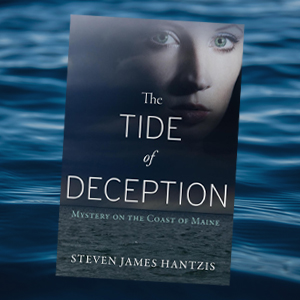From Where They Came
This Memorial Day allow me to introduce a few of the men who led by example and molded America’s modern Special Operations Force. They were British, part of a secret organization called the Special Operations Executive (SOE). During World War II, SOE commandos fought in every theater and found time to come to America and train groups within the Office of Strategic Services (OSS), the forerunner of the CIA. OSS commando units were called Operational Groups or OGs. The men in OGs were highly vetted, physically honed, and fluent in at least one foreign language. They weren’t spies; they fought behind enemy lines in American uniforms. Typically recruited from the U.S. Army and Marines, they were Norwegians, French, Italians, Austrians, Germans, Dutch, Hungarians, Spaniards, Poles, Czechs-Slovaks, Yugoslavs, Chinese, Korean, and Thai. And they were Greeks.
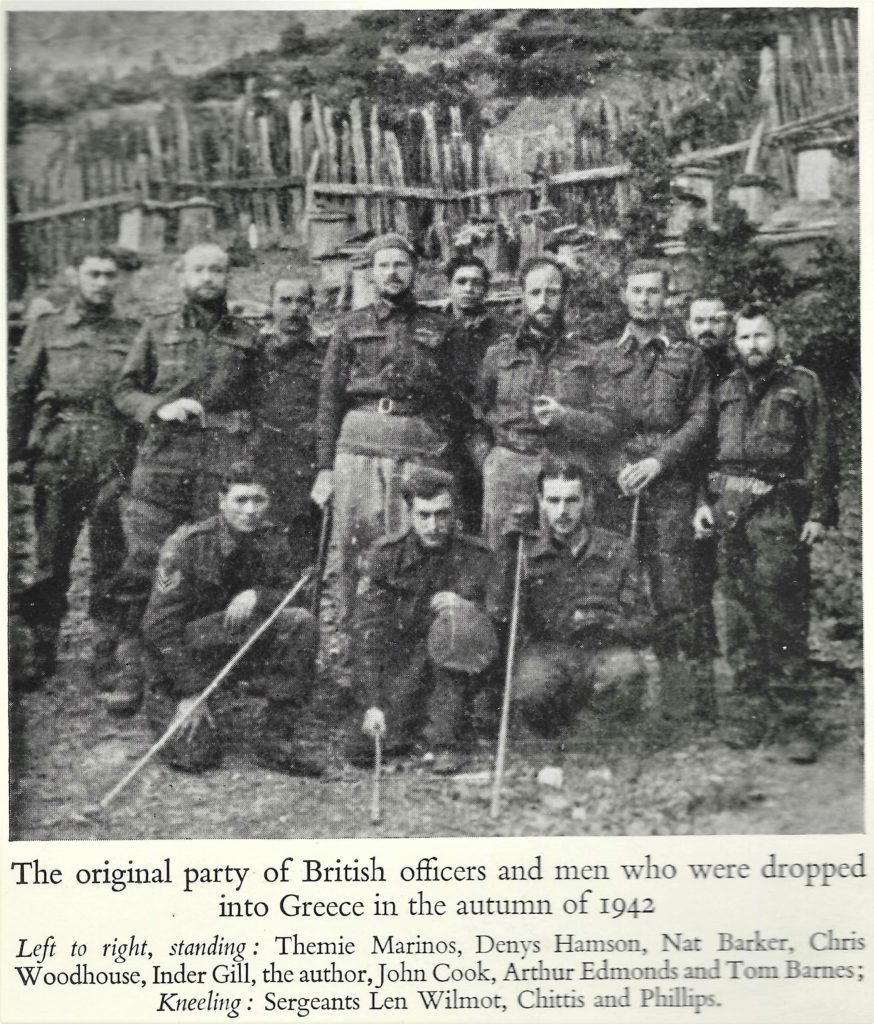
The manuscript I’m working on is American Andarte. Andarte is Greek for resistance fighter or guerilla. Greece was full of them during the Italian, Bulgarian, and German occupation of World War II. Most andartes belonged to either EDES or EAM-ELAS, rival resistance organizations within Greece. EAM-ELAS was larger and incorporated Greek communists, other progressives, and anti-monarchists. EDES was conservative and supported the king and accommodated the Germans. Believe me, Greek politics during World War II was complex. The book will supply details.
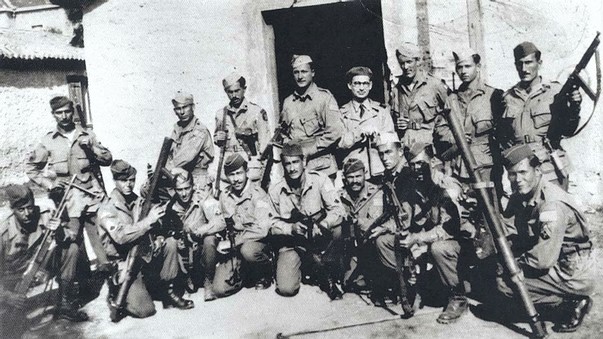
This vignette picks up in September 1942 with the first British SOE mission to Greece. The American OSS OGs would arrive a year and a half later in April 1944. Theirs is a fascinating story, classified until 1987. Until then, the CIA prohibited these American combat veterans from talking about their service. One hundred and eighty-one American OSS commandos served in Greece.
This is a section from a chapter in my manuscript so context might be foggy. The focus is on the British SOE and their first contact in Greece. The viaduct in this vignette is the Gorgopotamos Railroad Bridge. The sabotage of this crucial transportation link with the help of Greek andartes was their first SOE action. (There’s a great video about the mission featuring Monty Woodhouse.)
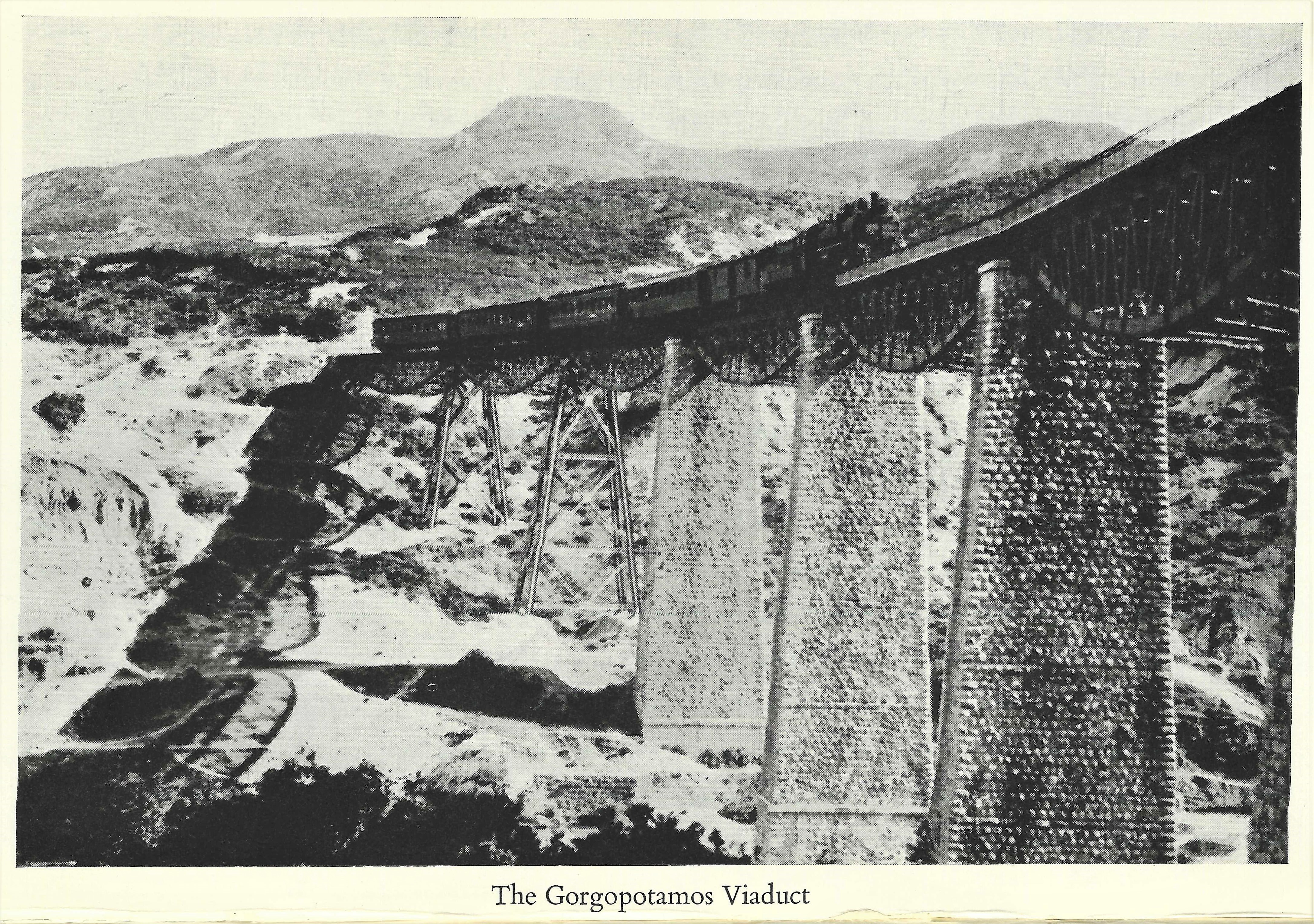
A few months later, the SOE struck again, this time alone. They brought down the highest railroad bridge in the country, the Asopos Viaduct, in an action believed impossible. Asopos is an entirely unique story covered in the manuscript and not for this post. It is enough to say that when the spans of Asopos Viaduct fell into the rushing river 330 feet below; the SOE made their mark on the history of warfare. The United States Army Special Operations Command today says that the attack on the Asopos Viaduct “was probably the single most spectacular exploit of its kind in World War II.” The Germans were so certain that the destruction of the Asopos Viaduct could only be an act of treachery that they shot the entire garrison guarding it that night.
Cairo, Egypt—September 1942
For all the complexity and drama that was Greek resistance politics, the Greek railway network was easy to understand. There was one standard-gauge mainline. It ran from the Port of Piraeus through Athens to Salonika in Greece, and from there to Sofia, Bulgaria, then Nis and Belgrade and Zagreb in Yugoslavia. At Zagreb, lines fanned out to Austria, Italy, and Hungary. The rail line carried forty-eight trains a day and completed an essential military line of communication. It stretched from the industrial centers of Germany through Piraeus to the Libyan ports of Tobruk and Benghazi. The Greek railroad was the only supply route with the ability to carry the weight of war. Over it rolled troops and supplies for occupation of the Balkans and the resupply of Rommel’s North Afrika Korps. It was a strategic target, of which the British took immediate notice. In the fall of 1942, they handed the problem to the Special Operations Executive (SOE), informally known as “The Baker Street Irregulars” or “Churchill’s Secret Army.”
On September 30, 1942, under a waning gibbous moon offering a bit too much light for the stealth intended, Lt. Colonel Eddie Myers, made a last check of men and supplies. Myers was a scrappy, assertive, thirty-six-year-old sapper from Kensington by way of the Middle East. The commander of the British SOE team climbed into an American-crewed B-24 Liberator on the tarmac of Deversoir Aerodrome. Deversoir was on the northern shore of Great Bitter Lake at the entrance of the Suez Canal.
Myers and three other SOE commandos boarded the first plane, and two more groups of four boarded two other planes. Each man, dressed in a British military uniform, carried an Enfield No. 2 Mk I .38 caliber revolver and a Fairbairn-Sykes commando dagger. They packed field dressings, and a Baker Street Kit comprising a compass that looked like a button, a map disguised as a silk scarf, a leather belt secreting two gold sovereigns, rations, torches, and poison pills for use if captured. They were parachuting into Greece. Their Sten submachine guns, grenades, and the detonators for their plastic explosives dropped separately in metal pod canisters.
They had done this before, two nights before. After flying four hours, eight hundred miles, over the Mediterranean into the mountains of Roumeli, Central Greece, they had turned away for Cairo. They had failed to spot the expected signal fires positioned to look like a cross. Tonight, was better. The pilot keyed the intercom and told Myers he thought he saw three fires burning in a valley below.
The snow on Mount Giona reflected the light of the moon and cast the palest glow on an alien world. The ancient name for Mount Giona is Aselinon Oros or moonless mountain. But tonight, the name misled. The Liberator descended to just above the peaks as Myers opened the bottom hatch in the airplane’s bay and jumped into the frigid darkness of the barely luminous unknown.
He fought updrafts from the mountain peaks. Buoyed and buffeted he blew away from his intended valley and drifted toward a forest of fir trees. He fought his heavy pack but couldn’t correct his descent. He landed high in a tall fir and crashed through its branches, ending on the ground with his parachute tangled above. His pack ripped from him in the fall, snagged on a stout limb and swung above. When he hit the ground, he sat for a few minutes in the snow and fir needles gathering his wits. The throbbing pulse of twelve, 14-cylinder Pratt & Whitney engines faded into the void. The Liberators were going home. It became silent, and Myers was alone.
There was no sign of the equipment pods or other commandos. Myers stood on the steep mountain slope, barely able to move without tumbling forward, and tried to stay calm. First, he lit a flare, and that drew no attention. Then he lit a bonfire which gave the same result. He stumbled towards the valley using trees as braking points for his descent. There in the valley, he met two Greek shepherds. Myers did not speak Greek, but the three pantomimed and worked out that they would stay put until dawn.
As the sun came up, Myers returned to the tree where he landed surprised that his parachute and pack were missing. That was when Tom Barnes, a New Zealander and one of Myer’s team, walked through the trees to Myers and the shepherds. He was unhurt. Barnes had received a signal from a third commando, Len Wilmot, and the two commandos went looking for him. The two shepherds went looking for the fourth commando, Denys Hamson, the only Greek-speaker in their group.
When the commandos and shepherds met at midday, the shepherds had found Hamson, and Wilmot appeared soon after. The team, one of three, was back together, intact, and Operation Harling was underway.
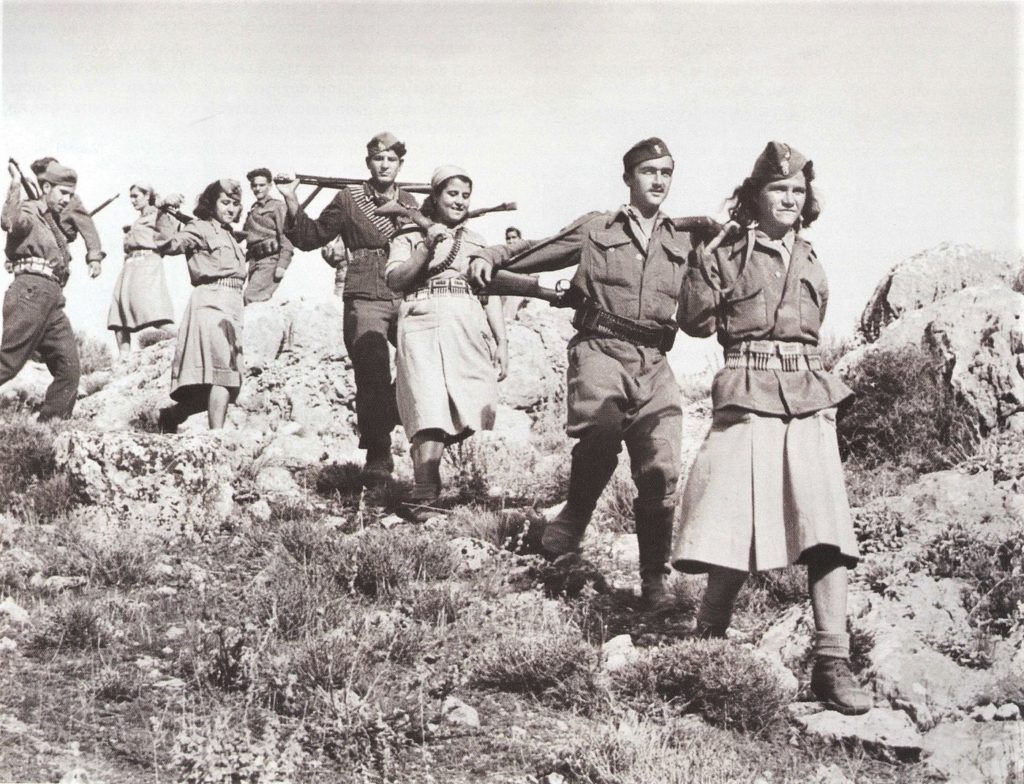
The second team, headed by Christopher Woodhouse, fared better. They landed seventeen kilometers north of Myers on the other side of Mount Giona. The four commandos landed without separation or injury. Soon Woodhouse’s team met, unexpectedly, armed men. The tension lifted when the andartes decided they were British and not German. The leader was a Greek who said he was expecting an explosive supply drop to blow up the retaining walls of the Corinth Canal. With him were two Cypriots, escaped prisoners of war.
The andartes led them to a village. There, Woodhouse, who went by Monty instead of Lord Terrington of Huddersfield, welcomed their equipment canisters retrieved by the villagers. But he watched in horror as children munched on the plastic explosive bars thinking they were fudge. They got sick but survived. Woodhouse, an Oxford-educated classics scholar and a fluent speaker of Greek, came first to understand the strangeness of occupied Greece, a country of scant resemblance to the land of Pericles.
Following the advice of a supportive villager the Woodhouse team moved to a cave on the eastern slopes of Mount Giona on a plateau called Prophet Elias. The cave was big enough to shelter all three commando groups. It was a three-day hike across a vast and rugged terrain. They trudged through deep snow in the valleys while the wind blew in gales cutting like the icy steel of a knife. Woodhouse welcomed Myers and his team and the two shepherds into their grotto sanctuary two days after arrival.
They knew the Italians were searching for them. The Italians had heard the Liberators on two nights. The SOE men moved to another cave that offered a better defense and tried to contact the third team.
The third team did not jump with the other two on September 30. They couldn’t spot signal fires and returned to Cairo. Three weeks later, they jumped blind and misjudged their location, dropping into the Karpenisi Valley near a large Italian garrison. Aris Velouchiotis commanded an EAM-ELAS unit that rescued the SOE team from certain capture. It took the three SOE teams a month to reunite.
Meanwhile, Woodhouse and Myers met the local EDES leader, Zervas, a short and rotund man of a carefree persona underlying his reputation as a brigand. Zervas controlled one hundred fighters. Later, they met Aris, the EAM-ELAS commander. He was thin, lanky, and hard-eyed, always alert and examining his surroundings. Aris commanded a larger, more disciplined force. His andartes controlled the territory on which rose the primary target of Operation Harling, the Gorgopotamos Bridge. But, before they could destroy one bridge, Myers had to build another.
To say EAM-ELAS and EDES were bitter rivals was to sugarcoat the reality. Both groups would not hesitate to attack and kill the other, given a provocation or a chance. Their politics clashed, and their leaders clashed. EAM-ELAS was the better organized and disciplined and larger. But British strategists fearing communist influence favored EDES. Myers and Woodhouse were to walk a diplomatic tightwire and forge a truce to carry out Operation Harling.
When they met with Aris of EAM-ELAS and Zervas of EDES, brandy helped to relax the grim Aris, and the carrot of arms and ammunition, and air support and resupply sweetened the proposition. Aris was less enthusiastic about the attack than Zervas. The EAM-ELAS top leadership believed that countryside military raids were less productive than urban actions. Aris was under orders “not to attack formed bodies of the enemy.”
Aris bucked EAM-ELAS leadership and agreed to take part. With the shaking of hands all around and toasts to the pact, EAM-ELAS and EDES pledged to work together for the attack on the Gorgopotamos Bridge. The British saw this arrangement as perhaps the start of a lasting reconciliation and a budding alliance between the organizations. But in Greece, the old is never far from the present.
Operation Animals set for June 21, 1943, called for an ambitious campaign of sabotage in Greece. SOE attacks with andarte support were to fool the Axis Powers into believing that Greece was the target of an Allied amphibious landing, instead of Sicily. Operation Animals was part of a broader campaign, Operation Barclay. This plan involved twelve fake Allied divisions, bogus troop movements, and corresponding fake radio communications. The deception was to fool the Germans into reinforcing Greece and forget about Sicily. Operation Mincemeat, the dead body, brought ashore in Spain, was part of Operation Barclay.
The British SOE commandos parachuted into Greece with three targets, bridges across the Papadia, Asopos, and Gorgopotamos rivers, all Roumeli railroad viaducts. Colonel Myers, while waiting to reunite with Woodhouse, reconnoitered all three and found Gorgopotamos Bridge the best choice.
Constructed in 1905 and considered an engineering marvel, the Gorgopotamos Bridge is ninety-five miles northwest of Athens. The bridge rises 112 feet to span the gorge and churning river for seven hundred feet. Gorgopotamos means the rushing river in Greek. Over it crossed a single line of railway, the lifeblood of Germany’s campaigns in the Balkans and North Africa.
As Myers crawled to his vantage at dawn, he could see through powerful binoculars the seven sub-linear spans supported by six pylons of the massive Gorgopotamos structure. The four central pylons were stone and would be impervious to the plastic explosives of the SOE. But iron piers, girders, and trusses supported either end. These would be the target for the four hundred pounds of shaped charges on the night of November 25, 1942.
One hundred Italians and five Germans guarded the bridge with pillboxes and heavy machineguns at either approach. With the SOE team of 12 and 86 fighters from EAM-ELAS and 52 from EDES, the attack would go forward with 150 fighters. The plan was simple, but the execution was treacherous.
Before 1100 hours, small groups of andartes went up the rail line both north and south to cut communications wires, halt advancing trains, and block any attempt at reinforcement. Then, at 1114 hours, all hell broke loose as the andartes attacked pillboxes at either end of the bridge. The southern position fell first with the Italians running to escape the attack. The northern defense fell when Myers sent his small contingent of reinforcements. As the attackers gained control of the bridge, the explosives team and eight mules made their way down the rough brush and slippery stones of the gorge. At the floor of the gorge, they waded into the powerful, unsettled currents of the river, and across a narrow plank bridge.
At the base of the bridge, the explosives team shaped and reshaped their charges and attached them to the girders. At 0130 hours on the morning of the 26th, the first explosion collapsed the two spans at either end of the bridge. The severed sections fell into the gorge with a crash to the cheers of fighters. An hour later, with explosives left over, the SOE sappers demolished the fallen spans where they landed. With the sky lightening at the hint of dawn, a green Very light spread an eerie glow on the gray-rose palate and signaled the retreat. The attackers withdrew at 0430 hours for a fifteen-hour trek to their hideout. The andartes suffered only four casualties and no killed-in-action. The SOE men were untouched and Myers estimated the Italian dead at thirty.
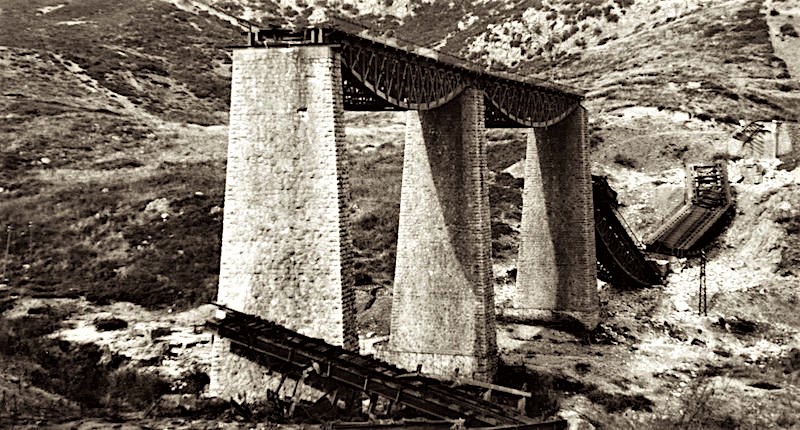
At the hideout, Myers expressed his gratitude to both Zervas and Aris. He told them the attack could not have been successful without them. Myers sent a messenger to Athens to arrange a supply drop of boots, clothing, arms, and whiskey for EDES and Zervas. Aris requested the same for EAM-ELAS, but Myers had no authority for the communist request. He instead gave Aris and EAM-ELAS 250 gold sovereigns. Myers told Zervas and Aris that he had recommended them for decorations and commended them for their service to the Allied cause. Zervas was grateful but Aris wanted none of it and told Myers he preferred boots for his fighters.
The German repair of the Gorgopotamos Bridge took six weeks, denying Rommel’s Afrika Korps two thousand trainloads of supplies. The repair to German respect for Italian courage under fire never happened. The Germans took over security for the entire railway system, straining their forces in Greece and the Balkans. Less than a month later, the 11th Luftwaffe Field Division moved into Attica north of Athens.
On December 1, 1942, ten villagers from tiny Ypati, hands bound, were marched to the rubble of the Gorgopotamos Bridge, and gunned down by the Germans. Four days later, the Germans killed another six hostages in the same way. It wasn’t the first blood retribution for the Germans in the administration of their doctrine of collective responsibility, and it wouldn’t be the last.
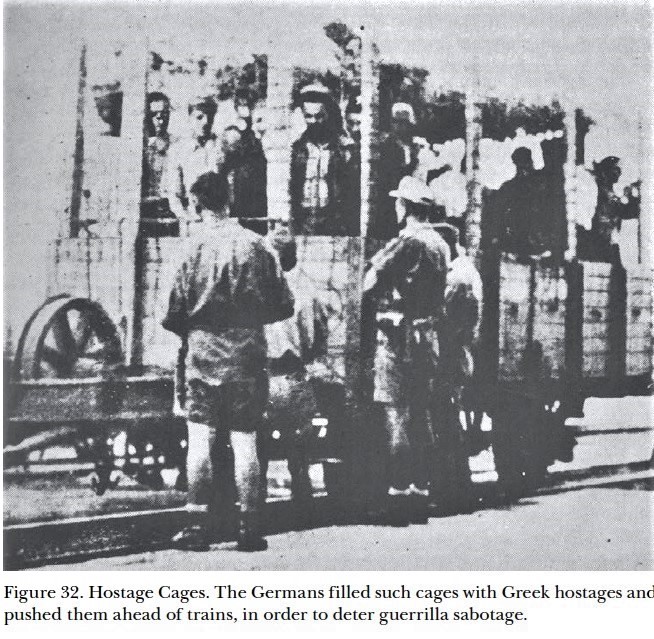
After Gorgopotamos, the Germans added klouves or crates to their trains. The Nazis filled these open railcars fenced with barbed wire with innocent Greek civilians, mostly women, and children. They coupled the cars ahead of the locomotives and shoved them first in line to discourage attack. It is impossible to overstate Nazi barbarity. Their crimes of taking hostages, and retaliatory killings, were sickening. At the Nuremberg Trials following the war, the Greek government reported 91,000 Greeks murdered as hostages and 800 villages and towns destroyed by the German occupation forces. – SJH Copyright © 2019 Steven James Hantzis
Notes
[1] http://oss-og.org/ [1] http://nzetc.victoria.ac.nz/tm/scholarly/tei-WH2-2Epi-c2-WH2-2Epi-j.html page 24 [1] Assessing Revolutionary and Insurgent Strategies, CASE STUDY IN GUERRILLA WAR: GREECE DURING WORLD WAR II, REVISED EDITION, United States Army Special Operations Command, page 58. [1] Myers, E.C.W. Greek Entanglement. Alan Sutton, 1985. https://books.google.com/books?id=NP1mAAAAMAAJ. Page 184. [1] Churchill’s Ministry of Ungentlemanly Warfare, The Mavericks Who Plotted Hitler’s Defeat – Giles Milton, page 206. [1] Churchill’s Ministry of Ungentlemanly Warfare, The Mavericks Who Plotted Hitler’s Defeat – Giles Milton [1] Myers, E.C.W. Greek Entanglement. Alan Sutton, 1985. https://books.google.com/books?id=NP1mAAAAMAAJ. Page 43 [1] Assessing Revolutionary and Insurgent Strategies, CASE STUDY IN GUERRILLA WAR: GREECE DURING WORLD WAR II, REVISED EDITION, United States Army Special Operations Command, page 29 [1] Using Robotic Theodolites (RTS) in Structural Health Monitoring of Short-span Railway Bridges, P. Psimoulisa,b *, S. Stirosa, a Geodesy Lab., Dept. of Civil Eng., University of Patras, Patras, Greece – stiros@upatras.gr, b Geodesy and Geodynamics Lab., ETH Zurich, Schafmattstr. 34, Zurich, Switzerland – panospsimoulis@ethz.ch, page 1 https://www.fig.net/resources/proceedings/2011/2011_lsgi/session_1e/psimoulis_stiros.pdf [1] Myers, E.C.W. Greek Entanglement. Alan Sutton, 1985. https://books.google.com/books?id=NP1mAAAAMAAJ. Page 44 [1] Assessing Revolutionary and Insurgent Strategies, CASE STUDY IN GUERRILLA WAR: GREECE DURING WORLD WAR II, REVISED EDITION, United States Army Special Operations Command, page 39 [1] Churchill’s Ministry of Ungentlemanly Warfare, The Mavericks Who Plotted Hitler’s Defeat – Giles Milton, page 218. [1] German Antiguerrilla Operations in the Balkans (1941-1944), CMH Publication 104-18 page 19. [1] Yada-Mc Neal, Stephan D.. Places of Shame – German and Bulgarian War Crimes in Greece 1941-1945. N.p.: Books on Demand, 2018. Page 137 [1] http://www.occupation-memories.org/en/deutsche-okkupation/Wichtige-Begriffe/index.html [1] http://www.occupation-memories.org/en/deutsche-okkupation/repressalien/index.html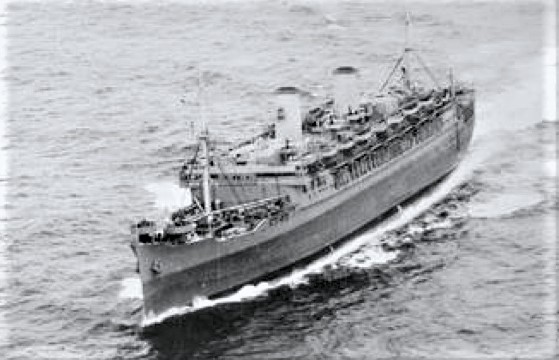
You’ve finished training, you’re inoculated, and your paperwork is filed. Now, it’s time to board an overloaded, repurposed luxury liner and outlast the chaotic sea and a determined enemy. You know not your destination, that they will tell you along the way. Your only clue is that you are sailing west from California.
Fifteen million men and women of the United States armed forces faced similar circumstances during World War II. Not all were going to India like the 721st Railway Operating Battalion and the five thousand GI’s in their Military Railway Service (MRS), but all were bound for the unknown. On Veterans Day, 2019, I hope this vignette helps us appreciate those who served at a moment in their lives when all that came before resolved into what lies ahead.
This vignette precedes the narrative in Rails of War, the story of my father’s railway operating battalion in World War II. The book follows the men of the 721st on their journey to India, through their twenty-two months in-country, through fires and famine, monsoons, and crippling heat, as they move the weight of war on a foreign, outdated system. At war’s end, with their mission accomplished, their return trip takes them around-the-world. If you’d like to read more about the 721st and the China-Burma-India theater, the book is widely available.
9 December 1943, 1600 Hours – Camp Anza, California
A gaggle of GIs went to the orderly room to check the shipping list the evening before, and there they were. Amidst the anxious cluster of young men staring at the cork bulletin board, one anonymous soldier piped, “Well boys, I guess it’s time for a boat ride. Don’t forget your swimsuits and bathing caps.”
The 721st had finally received orders to ship out, but the rumor mill had been working overtime for two days before that. Word had reached them from the docks in Wilmington that their locomotives, rolling stock, section equipment, and machine tools had arrived. So, they knew it wouldn’t be long.
Besides getting their gear organized and stocking up on last-minute purchases, most men wrote home knowing that they would not be able to mail any more letters until they got to wherever the Army was sending them. By then, all mail home would be subject to enemy attack. They had been under a communications blackout since furloughs were canceled at Camp Atterbury after Thanksgiving – no letters, no telephone calls, and no telegrams.
They didn’t much regret leaving Camp Anza. The camp had beer, malted milk, and ice cream at the Post Exchange. It had a comfortable movie theater and an enormous mess hall with generous portions of good chow, and all the fresh fruit the men could eat. Still, it wasn’t a place where you spent much time or grew attached.
The camp was named for the intrepid Spanish explorer, Juan Bautista Anza. In the 1770s, Anza was the first European to establish an overland trail from Mexico to the Pacific coast of California through the continent’s hottest desert, the Sonoran. The Spanish had been looking for such a route for over two hundred years. Like Señor Anza, most GIs were simply passing through.
In 1942, the federal government bought 1,239 acres sixty miles east of Los Angeles from the heirs of Willits J. Hole, a wealthy businessman, landowner, entrepreneur, and successful yacht racer of the 1920s. Construction began in July 1942, and the base was finished in February 1943. The Camp was officially activated in December 1942 as Headquarters, Arlington Staging Area.
Stays at Camp Anza were brief. The 721st spent ten days there. But the total population of the base often ranged up to twenty thousand. It was a bustling beehive of activity through which more than 600,000 troops passed during the war.
Camp Anza was a staging area whose purpose was to prepare soldiers for overseas deployment. Base personnel immunized soldiers and helped them write their wills. APO mail numbers were assigned so that loved ones could stay in touch. Furlough pay was issued. But Anza wasn’t all paperwork and needle pokes. The men practiced going over the side and became awkwardly proficient descending ship cargo nets.
The men checked and re-checked their clothing issues, and ordnance teams checked and re-checked their arms. Experts from the Chemical Warfare Section marched them into their final gas chamber to check their gear, and camp staff remedied all shortages and deficiencies.
Instructors held orientation sessions on foreign customs, and languages and outbound soldiers were briefed on the rules of war. The bureaucracy put to work hundreds of clerks to make sure the Army’s paperwork was in order, and at 1600 hours, 9 December 1943, the 721st Railway Operating Battalion was generating one of the final clerical entries in its stateside file.
The men stood at attention outside the orderly room for roll call. Sergeants noted anyone absent by circling their names on the alphabetized lists. If you were present, you got a checkmark.
After completion of the Army’s final inventory came the heavy lifting. Men heaved their eighty-pound duffle bags, shouldered their twenty-pound horseshoe rolls, braced their forty-pound packs, lugged their brand new gas masks, goggles, and protective capes, straightened their wondering twelve-pound musette bags and handed off their ten-pound carbines and eleven-pound Thompson sub-machine guns to buddies as they climbed aboard the shuttle train to Wilmington.
Stumbling his way up the steep steps onto the U.S. Maritime Commission passenger car, a nameless voice in the line said to no one in particular, “Well, at least we won’t have to worry about Jap subs, boys. With all this gear, we’ll sink at the dock.”
After all the grumbling and stumbling, the men settled in, and the train whistle blew as the Camp Anza Band struck Fred Waring’s popular tune This is My Country. As the locomotive took up the slack and the train pulled slowly away, steam hissed from the boiler valves, and coal smoke descended on the tuba and French horn sections, making them disappear in a cotton-like haze. But the band played on.
Through the orange groves and vineyards, the sun faded, and the electric lights in homes revealed families at dinner. Their calmness and normalcy struck the men as oddly out-of-place, like misplaced frames in a disjointed movie reel.
It was 1900 hours, and the sun dipped on the western horizon as the troop train reached the station at Wilmington. Some soldiers had fallen asleep with their four-pound steel helmets, and plastic liners pulled over their eyes, and others were wide-awake taking in the view from the passenger car windows.
The big locomotive coaxed the train to walking speed then pulled to a smooth passenger stop under the train shed. Many of the operating craft personnel silently noted the engineer’s skill.
The soldiers detrained and formed-up in a huge galvanized steel warehouse, one of many lining the dock. Officers called out the men’s last names, and when they answered with their first and middle initial, the sound echoed like they were yelling in a giant metal cave. Dozens of call and response exchanges took place all at once as 5,000 men assembled to board the ship in a cacophony of roll.
They lined up by twos and were greeted by ladies from the Red Cross with sandwiches, coffee, and cookies. After the quick but welcome snack, and a faint foreboding that they had eaten their last meal in the U.S., they began to march from the warehouse and past rows of docked ships towards the gangway of the S.S. Mariposa.
By now, everyone was wide-awake. Heads swiveled as awe-struck young men from the Midwest and other non-coastal states cataloged their strange new surroundings – the squawking, insistent gulls, buoys gonging in the harbor and the smell of saltwater. It was the first time most of the 721st had seen ocean-going vessels and the massive equipment needed for their maintenance. These were men who, for the most part, were familiar with large industrial settings and oversized equipment, but “My God,” many thought, “These things are enormous!”
The entire coastline from Los Angeles down to Long Beach Harbor, including the embarkation point at Wilmington, was a nexus of military operations and commercial activity. It presented the Japanese with a tantalizing target.
The maritime geography of Long Beach was opportune, and its doubly protected west basin port was only minutes from the open sea. The most concentrated stretch of tempting targets ran from Long Beach up to San Pedro and proffered an enticing strip of naval bases, shipbuilding properties, repair slips, docks, wharves, Coast Guard berths, supply depots, and oil fields.
Immediately before World War II, the U.S. Congress authorized the construction of a major anchorage and set up a fleet operations base called Terminal Island Naval Dry Docks in Long Beach. The docks began working on ships in April 1942, and by August 1945, employed over 16,000 civilians. These skilled workers provided battle damage repairs and routine maintenance to tankers, cargo ships, troop transports, destroyers, and cruisers. Consolidation Steel Corporation ran an eight-way shipyard next door in Wilmington building landing craft for the Marines and other ships. They employed over 12,000. The entire area was a twenty-four hours a day, seven days a week operation, and a busy place, even without the wide-eyed men of the 721st.
As they marched in loose formation under the bows of the iron giants, one wisenheimer in the rear ranks piped, “Hey, upfront! Turn right when you see the red carpet!”
A moment later, the same guy yelled up at a seaman, mopping the forecastle of a Coast Guard cutter, “Hey, Cap’n Ahab! Swab that deck and hoist that bale! I’m coming aboard the Pequod for inspection!”
He was still giggling and mouthing an unlighted cigar, delighted at his literary reference when the soapy water from the sailor’s bucket hit squarely on his helmet. It was a well-placed shot, and the GIs around him laughed hysterically though some got splashed as well.
The chuckling men were still ribbing the wet wisenheimer when their banter was drowned out from behind by two B-17G Flying Fortresses approaching low over the docks. The deep pulsating signature of their eight 1,200-horsepower Wright Cyclone GR-1820-65 radial engines shook the pier beneath their Type I service shoes disorienting the men.
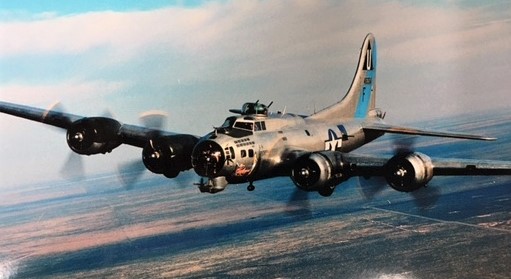
As they overflew the 721st column at less than 500 feet, the men gawked at the machine guns poking out of every conceivable surface of the plane, thirteen in all. The German Luftwaffe fighter pilots sent to intercept these monsters called the plane vier motor schreck or four-engine fear.
When the lead plane was within view of the whole column, the pilot slowly dipped the big wingtips, first the right and then the left. Then, with the low western sun glinting off their aluminum fuselages, the enormous birds banked right as if controlled by one mind and climbed into the warm Pacific sky soon out of sight. The men on the dock had no way to know, but the lead bomber was crewed and piloted by Class 5 qualified women of the U.S. Army’s Sixth Ferring Group, WASPs. They flew everything from trainers to Fortresses.
The sound of their powerful engines faded as the planes lumbered away from the waterfront. The B-17Gs were brand new on their way from the Douglas Aircraft plant in Long Beach to somewhere in the Pacific. The Long Beach Douglas plant was one of three making B-17Gs and on average, assembled four of the giant planes a day. The three plants combined turned out thirteen new bombers a day, and all were promptly put to use making rubble and carnage out of buildings and machinery and troops formerly prized by enemies.
As the aircraft passed from sight and earshot, a staff sergeant marching to the left of Company B thought to himself, “That might have been me if the railroad hadn’t jinxed things.”

The head of the column reached the gangway of the S.S. Mariposa and began climbing the long steps single file as each man’s name was read. The men below watched as their comrades disappeared into the yawning hole midship in the boat’s gray steel side.
Once inside the ship, the men were assigned quarters and told to go there and remain there until further notice. They dutifully wandered off through a maze of hatches, bulkheads, and companionways tunneling through a jungle of pipes and wiring.
Some of the lucky ones drew staterooms, but most found their ways to three-tiered bunks made of iron frames and canvas with rope slings. A few slept in hammocks built into every irregular nook and cranny of the boat. Some even had to sleep on deck in four-layer bunks protected from the wind and elements by plywood. These poor souls couldn’t even read after dark because they could use only blue lights to maintain blackout.
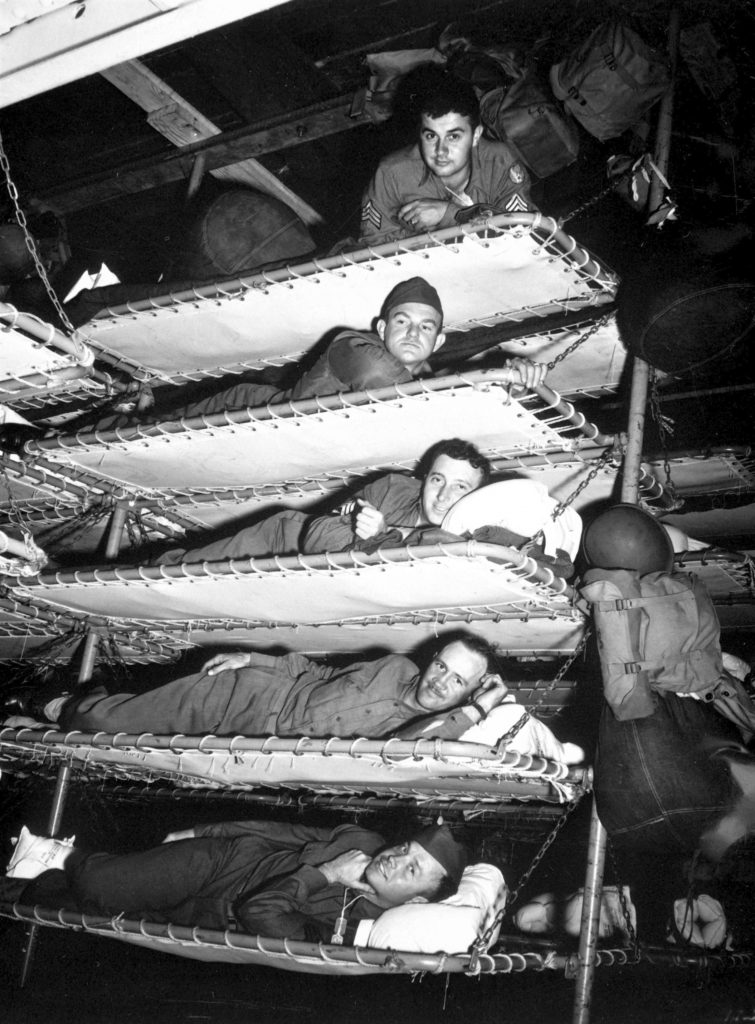
But all told, the men on this voyage were lucky. The Mariposa had made trips across the Atlantic, ten-day runs, where she carried twice as many men. On trans-Atlantic crossings, the soldiers shared bunks and slept in twelve-hour rotations. But the Pacific crossing was different. The men of the 721st would be at sea for a month with a brief stop in Hobart, Tasmania, for fuel and water.
A line of men not yet to the gangway eyeballed the Mariposa as they approached. They watched the twin loading masts, one astern and one on the bow, lift aboard pallets and cargo netted items. They studied the crew securing items to the deck and delivering loads into holds. It looked like a well-oiled operation, and that was heartening.
The big gray boat was longer than two football fields and had dozens of inflated life rafts tried along the railing on what looked to be the promenade deck. The inflated rafts were in addition to the wooden lifeboats mounted above the rafts on the same level as the twin smokestacks. The inflated rafts were obviously an improvised measure, and they were both reassuring and disquieting at the same time.
At 18,017 gross tons, the S.S. Mariposa was a large ship for her day. Designed by Gibbs and Cox, Inc. and built by the Bethlehem Shipbuilding Corporation in Quincy, Massachusetts, she was launched for the Matson Navigation Company in Los Angeles in July 1931. She was laid out to accommodate 475 first-class and 229 cabin class passengers along with 359 crewmembers. On this trip, she’d be a floating home and potential Japanese target for nearly five thousand souls, including the 651 enlisted men, 21 officers, and 1 warrant officer of the 721st Railway Operating Battalion.
The S.S. Mariposa entered troop carrier service in 1941. Her two Bethlehem Steam Turbines produced 28,450 horsepower and turned twin screws that could make 22.8 knots. The Mariposa wasn’t particularly fast, but she wasn’t slow, either.
She might outrun a sub that stayed submerged, but since she wasn’t heavily armed, a sub could always surface, chase her down and shell her or submerge and launch torpedoes. Any Japanese surface vessel worth its salt would have no problem outpacing her.
The Matson Navigation Company relinquished four passenger liners for troop transport after the attack on Pearl. The Mariposa and her three sister ships, the Lurline, Matsonia, and Monterey, would complete a wartime total of 119 voyages, covering one and a half million miles to deliver over 736,000 troops. A sterling and reassuring wartime contribution. Still, in 1943, no one knew the outcome of the war, let alone the fate of a single ship on a hostile ocean.
So, if anyone aboard the S.S. Mariposa the misty morning of December 10, 1943, had somehow yet failed to grasp the grand premise to which they were now party, it all became clear as the gangway rolled back, the anchor was weighed, the mooring lines were cast, and the foghorn sounded. As tugs began maneuvering the big ship to the channel, past the submarine nets, barking seals and minefields, every man on board the crowded ship somehow felt alone.
Their passage would deliver them to a strange realm halfway around the world. The journey would be made without escort or defense, and the lumbering ship would ply waters where the enemy was active, engaged, and deadly accurate.
Overfilled with men and matériel, they would be hard-pressed to outmaneuver or outrun anyone intent on sinking them. They weren’t so much a sitting duck as a big, fat, lame Mallard with only one leg to paddle. But they were smart. They had a few tricks of their own, and they had no intention of being plucked, stuffed, and mounted on the mantel of some lucky captain of the Imperial Japanese Navy.
So, Uncle Sam wished them all bon voyage, God Speed, and recommended that they kiss any rabbit’s foot, shamrock, Saint Christopher’s medal, or Shekel that they might have handy because the odds were with the other guys on this trip. – SJH
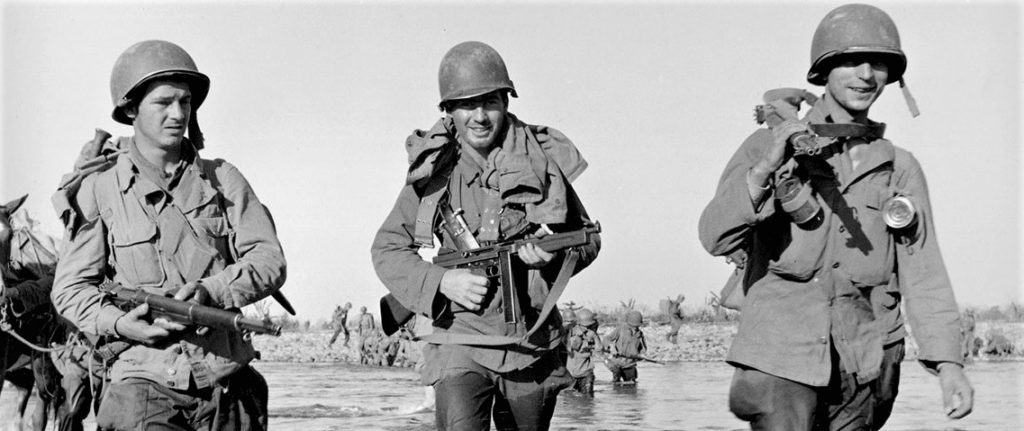
Seventy-five years ago, August 1944, Merrill’s Marauders captured Myitkyina in northern Burma eight hundred miles from where GI railroaders left them. The Marauders spent seven months in the most unforgiving jungle on earth. Their exploits are legendary. They fought thirty-two engagements including four major battles for which they were neither intended, trained, nor equipped against the entrenched, battle-hardened Japanese 18th Division. The Marauders won every time.

Then came Myitkyina. The battle lasted three months. The American victory allowed the Allies to finish the Ledo Road, secure the supply line to China, and General Slim to launch an offensive to retake Burma in December. The battle required all American hands on deck. Even men from the 721st and other railway battalions deployed to Myitkyina. Most of the 160 railroaders detailed to Burma were good men. But some volunteers were guys who were in trouble with their battalion brass; guys for whom Myitkyina was an alternative to disciplinary action. Once in Myitkyina they became the 61st Composite Group and courageously operated Jeep trains, called Bailing Wire Cannonballs, over the thirty-one miles of railroad between Myitkyina and Mogaung.
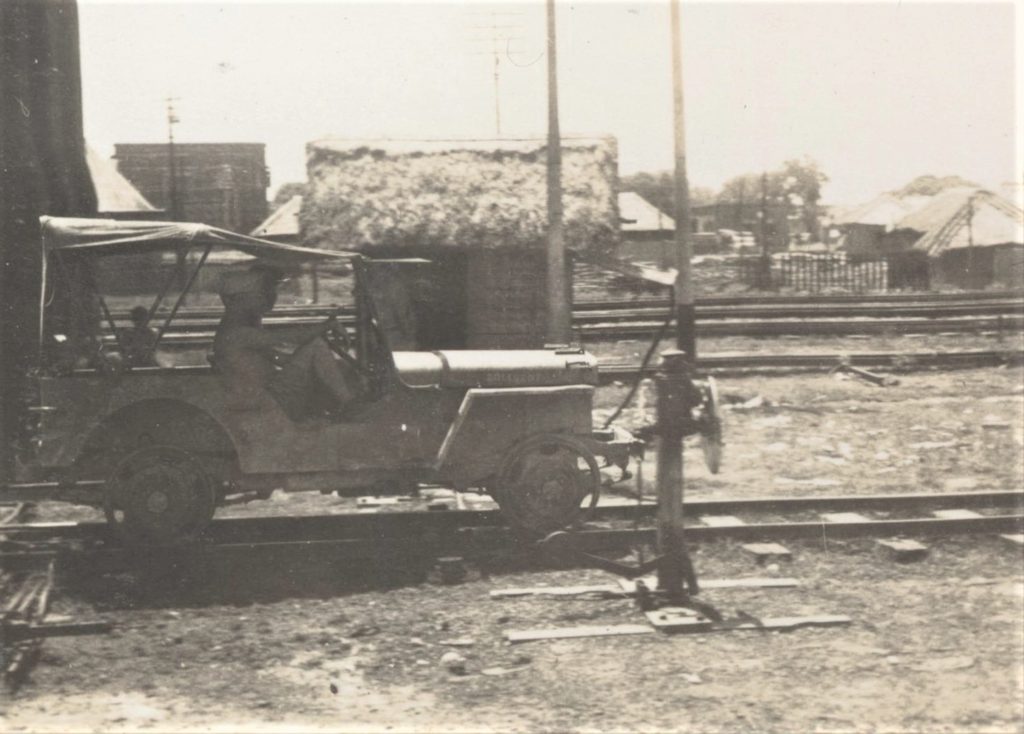
The 61st Composite Group used Jeeps for motive power because the Japanese had buried the flat rods from all but a couple of the captured locomotives. So, the resourceful GIs got busy replacing the wheels on Jeeps with rims from six-wheel-drive GMC trucks to fit the metre track gauge perfectly. Then, they chained two Jeeps together and pulled two or three flatcars loaded with troops, pipeline supplies, oil, and gas. GIs rode the flatcars to apply the handbrakes because the trusty little Jeeps had no stopping power.
To attack Myitkyina, the Marauders marched over jungle and mountain roads and paths, hacking new trails when necessary. They carried all their equipment and supplies on their backs with the help of horses and pack mules. They re-supplied by airdrops.
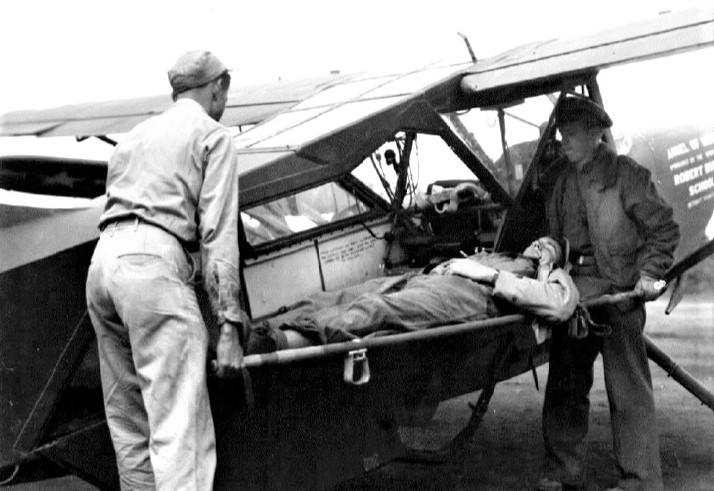
The Marauders evacuated every sick or wounded comrade. They carried casualties on makeshift stretchers of bamboo and field jackets or shirts to improvised evacuation points. These evacuation points where often remote jungle villages where the Marauders hacked out landing strips. Or, if a landing strip wasn’t at hand, they used supply drop zones, or rice paddies, or gravel bars along rivers. Brave pilots of the 71st Liaison Squadron landed and launched their sturdy Piper and Stinson evac planes in desperate conditions. The aircraft, stripped of all equipment except a compass, had room for the pilot and one stretcher — a third man onboard tempted fate.
In February 1944, 2,750 Marauders, at the peak of physical conditioning, assembled at Ledo on the Indian border and prepared to enter Burma. When they disbanded in August, they had suffered 272 killed, 955 wounded, and 980 evacuated for illness and disease. Only two of the original 2,750 survived with wounds or illness not requiring hospitalization. The following vignette is from an actual account and offered with authorial license.
My wife, Kathy, and I were honored to attend the U.S. Army’s China-Burma-India Final Round in 2005 with Rocky Agrusti, a 721st Railway Operating Battalion veteran. At our table were two Marauders who told us they had recently visited Burma. “Good grief,” I said, “You went to a country run by a military dictatorship and drug lords, with poverty and violence unrestrained? That must have been terrifying.”
The Marauder nearest me leaned in and said, “It was bad. But it was worse the first time.”
17 May 1944 – Hkumchet, State of Kachin, Burma
Corporal Harry Stevens slung his Thompson over his left shoulder and thought to himself, “Boy, I’ve seen some strange sights since I volunteered for this godforsaken outfit, but this one tops them all. God help us. This must be a first in aviation history…human catapults. If the Japs are watching, this’ll be one they’ll tell their grandchildren if I don’t kill the son-of-a-bitches first.”
A Piper L-4 Grasshopper had put down in a clearing about the size of a football field. The little airplane made the dangerous landing to evacuate a scout from I&R who had gotten badly shot up when his platoon stumbled across a Japanese machine gun nest the night before and a very ill Colonel Henry Kinnison, Jr., the unit’s commander. The clearing was soggy when the plane landed, and in the half-hour, it took to refuel and round up the wounded, a cloud burst drenched the field. Now, parked in a low spot in the clearing the plane’s main landing gear was half-submerged, and its tail-dragging third wheel was completely underwater. K Force was ready to move out, and if the Grasshopper’s passengers didn’t get help soon, they’d be goners.
Harry grabbed the side edge of the left rear wing just behind another GI. Two GIs on the other side of the airplane did the same. Four other GIs, two under each wing, pushed against the struts that ran from under the cockpit to the middle of the overhead wing.
With the pilot and the two wounded GIs aboard the rugged little plane weighed around one thousand pounds. Under normal circumstances, the L-4 would need about five hundred feet to takeoff. But nothing was normal in Burma. Harry and his buddies were there for a few more horsepower to complement the sixty-five that the Piper’s trusty air-cooled, flat-four Continental O-170 could deliver.
The GIs turned the little plane into the wind which, fortunately, was now stiff. A lanky GI in coveralls cocked the propeller and made ready to give it a spin as the pilot silently worked his checklist, “Contact, brakes, magnetos hot.”
With a thumbs-up to the GI standing in front of the plane, the pilot reached for his throttle control, and the GI gave the propeller a counter-clockwise spin. The little engine fired on the first try with a puff of blue smoke. The GI in overalls moved out of the way holding his cap on his head with his right hand. The pilot kept his feet on the brakes and advanced the throttle to the fully open position. When the RPMs hit 2,300, he released the brakes. The GIs on the rear wing ran an awkward sort of crab-shuffle and lifted the plane, raising the third wheel out of the paddy to reduce drag. The GIs in front pushed against the struts and ran as fast as they could.
They were a memorable sight with their carbines and Thompsons swinging on their shoulders and their bare asses showing through the slits they had cut in their tattered uniform trousers. Their bare asses were the sight that Harry thought the Japs might remember best.
They slit their trousers because all the GIs had dysentery and taking their pants down to relieve themselves was a waste of time and dangerous to boot. The voice of his sergeant from basic training came back to Harry now as he lifted the plane’s tail and ran sideways through the shin-deep mud tripping over the equally clumsy GI next to him, “Don’t get caught with your pants down, soldier!” Harry had heard this common chide dozens of times before volunteering for the 5307th, but it wasn’t until he started fighting in Burma that it rang true.
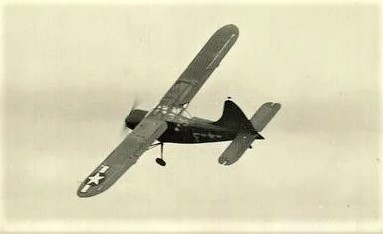
As the Grasshopper reached dryer ground its speed gradually outpaced that of the men’s and the GIs watched it take to the air in a sharp, steep climb out of the jungle clearing. As the little plane disappeared, Harry straightened his Thompson and stifled a humorless chuckle. – SJH
The river was muddy and wide. In the northern distance, the brick-red roof and gold weathervane atop Mount Vernon’s cupola graced its western bank. Talk about history. The window wall of the Fort Belvoir Officers Club was panoramic and the view breathtaking. This was the celebrated venue of the Saint Martin’s Military History Club, my gracious host for a Rails of War presentation.
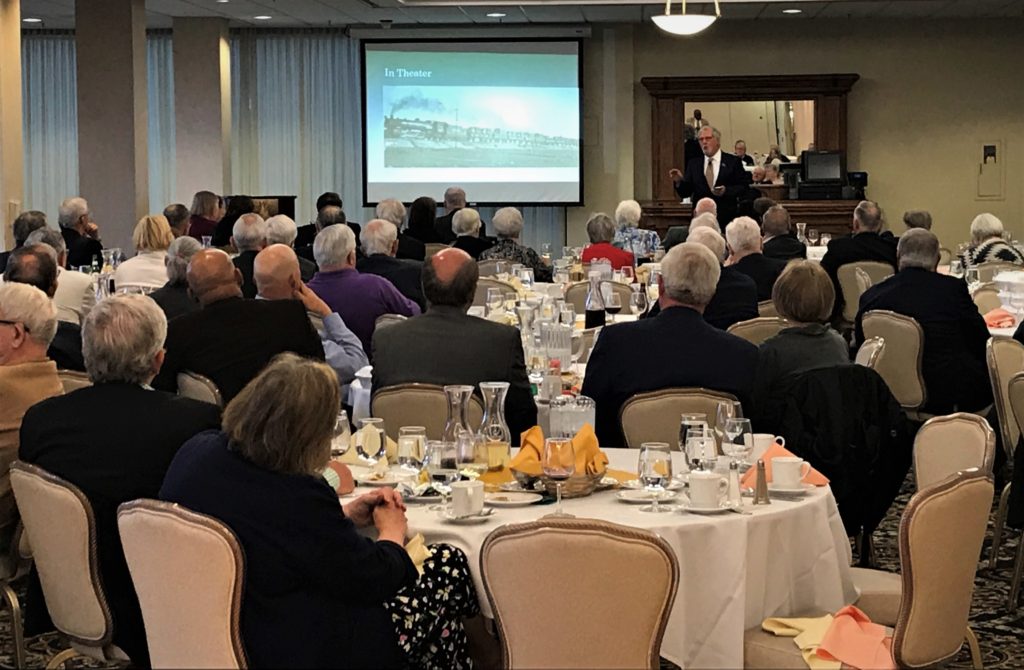
Saint Martin of Tours, for those like myself not well-versed in Catholic hagiography, was a Roman soldier turned pacifist who embraced Christianity on the cusp of its legal ordination in A.D. 313. Martin shared his soldier’s salary with the poor, famously clothed a freezing beggar with a part of his paludamentum, his cape, and thereupon envisioned the beggar as Christ. Martin left the army, lived as an aesthetic, and founded the first monastery in Gaul, a Benedictine affair. After raising two souls from the dead with prayer, and a plethora of deserving spiritual acts, today’s canonized Martin is a patron of the poor, soldiers, conscientious objectors, tailors, and winemakers. At the Fort Belvoir Officers Club, we had the soldier demo well-covered.
Saint Martin’s membership is smart, curious, and well-versed. There was more military acumen in that room than I could muster in a lifetime. What I had working for my presentation was that the China-Burma-India theater of World War II, often referred to as “The Forgotten Theater,” was a passably novel subject matter. It was a great evening, a great dinner and a fortunate introduction to new friends and old surroundings.
Fort Belvoir, nine miles south of our home in Alexandria, is in our backyard. First used in 1915 as a construction and engineering center it is today, much larger, more mission-diverse, and presently attuned to research and technology, some of which can be publicly acknowledged. But, for my money–and that’s a literal statement because we are supporters–what is yet to come is most interesting.
Fort Belvoir will be the home of the National Museum of the United States Army. Construction is underway on eighty-four acres with a planned opening in 2020. The museum will be grand, guaranteed. I’m happy for the Army, those who served, and our nation, but it will mean more traffic in our neighborhood, a preoccupation in the D.C. Area. If you’d like to support the museum, follow the link. They make it easy and offer a level for every contributor. So, thanks again to the Saint Martin Military History Club for the invitation to talk about Rails of War and thanks to the men and women of Fort Belvoir for their service and dedication. Therein lie countless stories yet told and I humbly encourage everyone who came to me with the question, “How do you write a book?” to find out as I did, begin by telling the story. – SJH

Happy people, I didn’t see a scowl all weekend, Buddha all. And, before I offend Buddhists, I use nirvana in an unexamined way, a colloquial synonym for Christian heaven. But, as true Buddhists know, nirvana is the extinction of desire, and in that sense, the Amherst Railway Hobby Show is the opposite. The show is an irresistible inducement to material lust. Any and all railfan hobby stuff can there be purchased in one of the four expansive pavilions that draw upwards of 45,000 paying entrants over two days. Thus, the show is more like wafting a dish of Gifford’s ice cream under the nose of a newly sugar-free devotee during Lent.
The attendees were a determined lot. At nine o’clock sharp, on a cold and snowy Saturday morning, they flooded the entrances after queuing outdoors for who knows how long. The massive parking lot of the Big E was nearly full when we arrived early. By the way, the Big E, also known as the Eastern States Exposition, is a not-for-profit with a board drawn from all six New England states. It’s huge. The Big E is the West Springfield, Massachusetts home of the New England Fair. (Not a state fair.) At the Big E, all of New England gets to show. Every September you can visit and get your fill of sheep shearing, deep-fried cheesecake, maple syrup, and cotton candy. Last year’s total attendance was 1,543,470. Who knew?
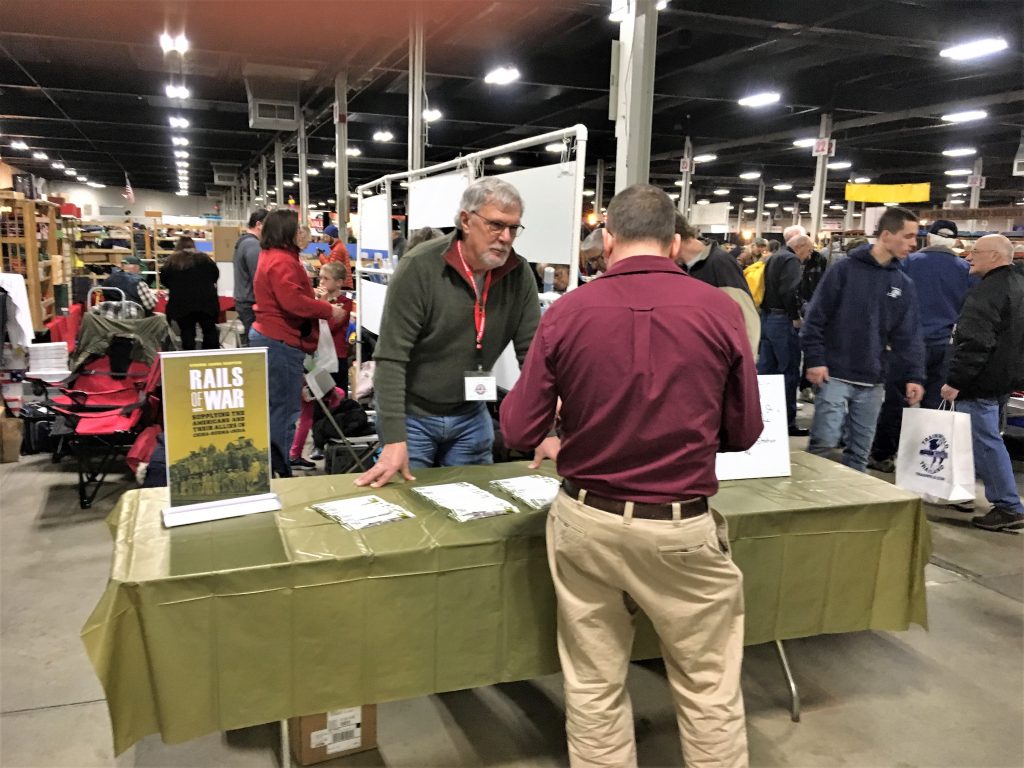
Rails of War displayed near the Dunkin Donuts outlet in a sea of vendors selling every miniature railroad artifact under the sun. Kathy was amazingly patient and supportive. She gave up our usual warm-and-sunny-spot-vacation timeslot to follow me to West Springfield in late January to talk railroad. Yes, I married well. I started a hundred conversations with, “Rails of War is the story of my father’s railroad battalion in World War II. The 721st operated in the China-Burma-India theater in present-day Bangladesh.” Then, nine times out of ten the person to whom I was talking would launch into a story about a relative who served in World War II or confess that he or she was an avid history buff as well as a railfan.
And so it went. For two days. We sold books with the proceeds going to the Amherst Railway Society, and we met many colorful and connected folks. In the crass world of commercial publishing, the weekend was platform development. In my world, it was meeting a bunch of new people.
The railfan hobby–people who build miniature and not-so-miniature railroad layouts, and people who photograph, paint and draw railroad equipment and train movements–falls neatly into the category of ferroequinology. Students of Latin, do you see it? Two parts Latin and one part Greek? The study (ology) of iron (ferro) horses (equine). Clever, eh? After twelve years working as a freight brakeman-conductor for Conrail in one of its busiest divisions and after thousands of hours listening to breakroom banter and onboard tête-à-tête, I learned a new industry word at the Railroad Hobby Show.
My modest career as a ferroequinologist began at a very young age, without an understanding of Greek and Latin. My initiation was by proximity to another ferroequinologist, my dad. James Hantzis was a railroader, a journeyman machinist for the New York Central at the massive Western Division Beech Grove Shops just southeast of Indianapolis. Those shops and the entire town of Beech Grove were built by another ferroequinologist, Frederick William Vanderbilt, for $3.5 million in 1906. Vanderbilt may have known the term, he was Yale educated. I don’t know if my dad knew the word, but he got a solid education at Indianapolis Arsenal Technical High School and later his NYC apprenticeship.
We lived in Beech Grove in 1949, the year I was born. For Christmas that year my mother gave my father a Lionel train set. I was exactly seven weeks old when the present was unwrapped, so I had no idea how cool it was. I doubt that I had any thoughts of any sort. My brother came along a year and a half later, and in short order we figured out just how cool the electric train was. The Lionel set included a locomotive and tender, a milk car with a uniformed man that delivered metal canisters onto a platform, a log car, a hook car, and a caboose. Oh, and it smoked, and had a whistle, and a headlight. And, it still works to this very day. Which is amazing.
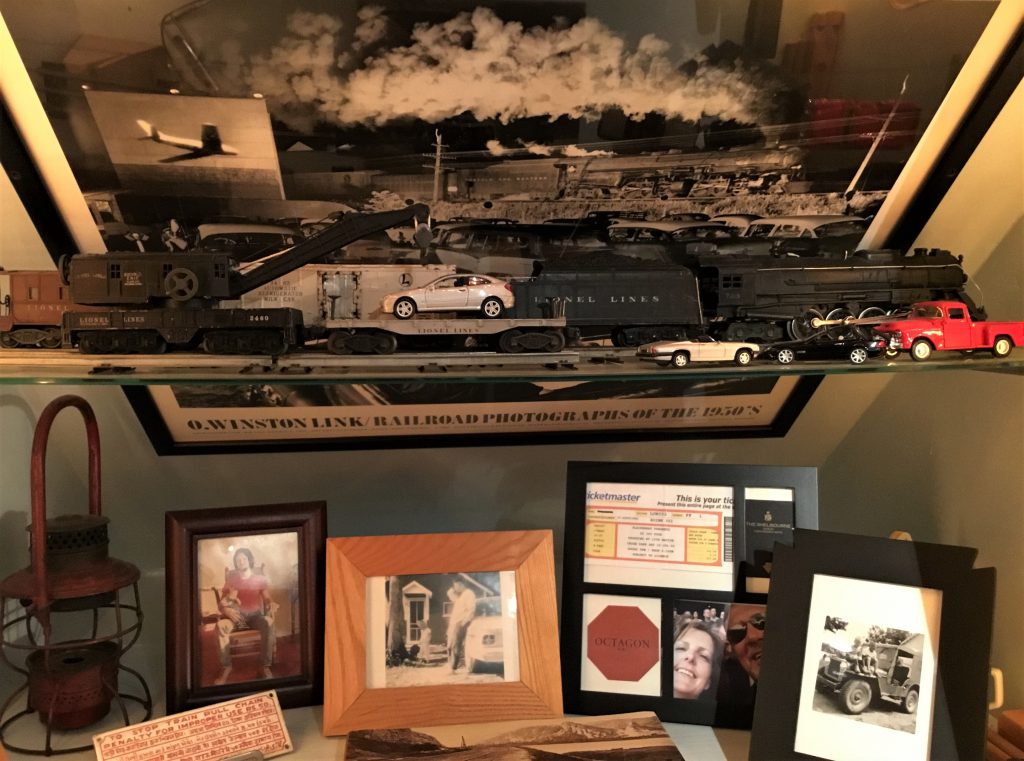
My brother and I loved to play with the train, but we played rough. We built Lincoln log cabins and set them on the tracks. We staged model car “accidents.” We may have even set something afire and ran the train through. We were not respectful. I’ve gotten better with age. Now, dad’s train is retired and on display under a big O. Winston Link print. I was for all these years a
Thanks to John Sacerdote, the show director and President of the Amherst Railway Society, for inviting Rails of War and providing a table among the 450 vendors. We were honored to be a part of the show’s fifty-year tradition. – © 2019 Steven James Hantzis

Anticipating two days of gritty talk at the upcoming Amherst Railway Society Railroad Hobby Show, I’m posting this first-hand, railroad-lingo-laden account from my long-ago operating career. — Photo credit Dave Seitzer.
Railroading is like boating. To do either safely requires “local knowledge,” knowledge of details that don’t show up on nautical charts or in railroad timetables. For instance, our house in Maine is on a back channel of the Sheepscot River, and some electronic nautical charts don’t show the depth soundings or the channel. That can be a problem for an inexperienced boater. My friend, Andy, had just such a problem in his converted tugboat, Loon, on his way back to his mooring at the Boothbay Harbor Yacht Club after a raft-up at Ovens Mouth. But Andy, an experienced and qualified mariner used his local knowledge and followed the lobster trawl buoys since they are usually in deep water. Hence, local knowledge kept Andy from grounding on one of Back River’s prolific mud flats known for their excellent clamming. Where to buy those clams also qualifies as local knowledge.
Railroading requires local knowledge even though you’re unlikely to ground a locomotive on a mud flat. Still, you need to know other things like what direction cars roll on a given track or yard or what switch you double dogged because it tends to leave a gap at the points. There are a million details you need to know.
Between Indianapolis and Petersburg, Indiana is a 125-mile section of track, part of the old Indianapolis & Vincennes Branch of the Pennsylvania Railroad. Along it, move empties southbound to Ashby Yard in Petersburg and cars full of fossil fuel northbound to the Indianapolis Power and Light Harding Street Plant. At least, that’s the way things worked, circa 1974-86. Indianapolis could be all solar by now; I don’t know.
The Petersburg line was slow, and the jobs that worked it dispatched at night. When you “marked-up” on the job you would usually work 12-hours and “die” somewhere past Washington, Indiana. To a railroader, the term die means to run out of operating time. 49 U.S. Code § 21103 says that operating craft employees are limited to 12-hours on duty unless it’s an emergency. When your 12-hours expire, you park the train, and the railroad sends a “cab” to take you to your terminus, and the dispatcher calls a fresh crew to finish the job. On the Petersburg job, the terminus was a cinderblock bunkhouse only feet from the switching lead in Ashby Yard.
Sleeping in a cinderblock bunkhouse during the day, in a well-used bunkbed, with a first-trick yard crew switching coal cars just outside, requires getting used to. I never did. Free-rolling hopper cars coupling together register somewhere between jet engine and jackhammer noise. When the first-trick yard crew finished, around 4:00 p.m., the “rested” road crew got the call to take the train north.
The northbound job left Ashby Yard around 6:00 p.m. The railroad was slow, and the train would cross the East Fork of White River in about an hour. Once over the river, we entered turkey farm country outside of Washington. Acres and acres and miles and miles of dirty white turkeys. With luck, the train was upwind.
The town of Spencer, about sixty miles north of Washington, had special railroad rules. Lots of local knowledge. Spencer is the county seat of Owen County named for Abraham Owen, a colonel who died at the 1811 Battle of Tippecanoe. But, don’t confuse Spencer with Spencer County named for Captain Spier Spencer, also killed at the Battle of Tippecanoe.
Spencer the town and Owen County seat has an old limestone courthouse like many Indiana counties. It’s a tidy building set on a block of well-tended lawn with the town’s main streets bordering its four sides. Unlike other courthouses, it has a railroad running right along its northern border, alongside Franklin Street.
Special rules in Spencer held that a coal train rumbling through town couldn’t blow its whistle. The locals didn’t want commerce to disturb the peace of their bucolic utopia. Fair enough. But, there were no railroad traffic control signals, no gates that block traffic on the intersecting streets. So, it was decreed that trains must go slow clanging the locomotive bell all the way. It was further decided that the head brakeman must dismount from the front of the engine, run ahead of the train, and drop lighted fusees into the intersections for people who had difficulty seeing a 120-car coal train passing through at walking speed. That was my job.
Local knowledge, or lore, holds that one time on a northbound trip a logging truck tried to beat the train across the intersection on the northwestern corner of the courthouse. The logger didn’t make it. The lumbering coal train T-boned the trailer pushing it like a bulldozer blade. The accident happened in slow motion since the train was only moving at a walking speed. No one was hurt, not even the local police officer manning the flimsy cop shack on the courthouse lawn that was swept along with parked cars, pick-up trucks, and other unlucky detritus. Local knowledge can be entertaining as well as instructive.
Indianapolis is another fifty-five miles northeast of Spencer. There, we switched out the Harding Street power plant and continued to the Big Four Yards in Avon. To get to Avon the train negotiated a ‘Y’ intersection just north of Morris Street. The ‘Y’ was usually lined in the west direction, the correct alignment, but you had to be careful because sometimes a yard crew would use the east route to get into the Chrysler foundry and not reline the switch. Again, the train moved very slowly along this track.
Near the ‘Y’ junction, and I mean right alongside, was “The Little Spot Tavern,” also known as “The Spot.” The Spot was a rickety shack with a decor that mimicked the inside of a well-traveled 42-foot semi-trailer. The furnishing fit its clientele smartly because everyone who frequented The Spot had just clocked-out or were getting ready to clock-in at one of the dozens of truck docks on West Morris Street. I don’t think the place ever closed.
As a low-seniority brakeman-conductor, I was “cut-off” or furloughed when business was slow. My employment fallback was to activate my Teamsters Local 135 membership and work “casual” on union truck docks. I would visit The Spot with my friend Jeff after working the third trick at McClean Trucking Company. Around 7:30 a.m. The Spot was buzzing; loud talk, political arguments, canned beer, profanity, and occasionally, falling-down-drunk patrons. And, as was the custom, wisenheimers who weren’t yet falling-down-drunk, might carry their passed out buddy to the railroad and leave him on the track for what I presume was a joke.
As a diligent, if sleep-deprived head brakeman, I checked for two operational concerns when the train approached the ‘Y.’ First, was there a drunk on the track? And secondly, was the switch lined to the west? Of these two matters, my Conrail timetable covered only the switch. The other was local knowledge. – © 2018 Steven James Hantzis
Tough Guys
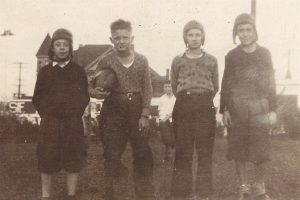
Jim Hantzis, 2nd from left, Mary O’Donnell’s brother, Chuck, far right. Circa 1931, Indianapolis
Veterans Day brings to mind a theme that pops up at every author presentation I make. It goes like this, “My relative (dad, uncle, grandfather, cousin) served in World War II, but he never talked about it.” I think I know why. When I was a young man, my father told me that “The tough guys never have to tell you how tough they are.” This, I believe, was a widely held masculine norm in his generation. A norm that many of today’s public figures would do well to embrace.
The war was tough, no matter where you served. Some had it tougher than others, no doubt, but the norm held sway. In today’s culture of Facebook celebrity and political overstatement, instant gratification, and the pathetic pursuit of “likes,” talking about one’s toughness, indeed, flouting one’s self-declared toughness, has all but swamped our more composed natures. Damaged role models abound. I prefer the quiet composition of my father’s generation and knowing that the tough guys never have to tell you how tough they are.
The following vignette was edited from Rails of War. My author’s draft was one thousand pages and two volumes. This didn’t make the cut. Still, I think this short story might be of interest to those who wonder why their loved one never talked about the war. Reticent loved ones weren’t deficient, they were likely more composed and actualized than the blowhards we are bombarded by today, in my humble opinion. So, what follows is a true story about Jim Hantzis, Jim O’Donnell, Mary Hantzis and Mary O’Donnell, their kids, a pet dog, and rabbits. Oh, and the USS Indianapolis and the atomic bomb. I hope you enjoy.
When I was a young boy on our farm in Indiana, my father hunted rabbits with his best friend, Jim O’Donnell. They’d stalk the fields, fencerows, frozen plow furrows and woods with determination and dexterity. Both men were pretty good shots. You could say that Jim O’Donnell was a bit over-qualified for shooting rabbits since he had been a Weapons Technician Grade Three in the U.S. Navy during the war.
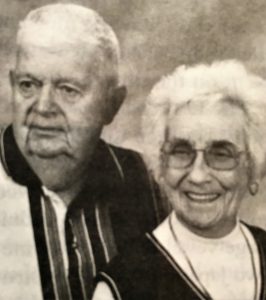
Jim and Mary Alice O’Donnell
Jim O’Donnell would drive out from Indianapolis with his wife and two sons, Tommy and Jim, and the grownups would organize an expedition, a not-so-big game foray, into the far reaches of our humble forty-acre farm. The Marys, Jim O’Donnell’s wife’s name was Mary as well, Mary Alice to be exact, would stay inside in our old farmhouse in the relative warmth of the oil-burning space heater and cook fried chickens, freshly dead after a mortal encounter with my neck-ringing, farm-girl mother, and mash the best potatoes on the planet. If the hunters were successful, the Marys would fry the rabbits as well.
When the Hantzis and O’Donnell families got together, there was salutary efficiency. There were three Jims, two Marys, two Toms, and one Steve. Four names for eight people.
The hunt would begin just behind our garage and fan out to all of the nearby farm buildings. The smokehouse, barn, and corncrib were built on fieldstone foundations. That’s the construction technique where a big rock is used to set a corner post, and the entire structure rises dependent upon the rock not settling too far. Poured-concrete foundations were still on the wish list when previous owners put up the outbuildings on our farm.
The good thing about a big rock foundation is that it allows all sorts of critters to live under the structure where they can eat grain and whatever falls between the inevitable cracks in the floor. Rabbits were one such critter. Besides being dead rabbit-totters, the boys were rabbit flushers as well. The advantage to using the boys was that the boys didn’t suffer from the family dog, Sky King’s, bad habits. The boys never chased the rabbit until it was full of buckshot, unlike Sky King. Also, the boys understood a few more commands than Sky King.
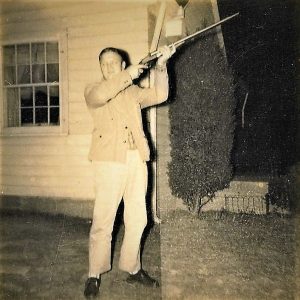
Jim Hantzis with 1925 LC Smith Field-Grade Featherweight
And by the way, here’s a tip for eating rabbit harvested by a shotgun. Watch out for buckshot! You never get all of the shot out when you clean the little critter and lead is really difficult to chew. Buckshot is hell on teeth no matter how much tug of war you play with the family dog.
It would take a couple hours to work the usual hunting areas. Then we’d return home, take off our muddy clothes and boots in the semi-heated utility room and make a beeline for the space heater in the living room. If we’d bagged some rodents, the final outdoors activity was to nail their hind feet to a board on the side of the garage, gut them and strip the fur off them. I remember being surprised that removing the skin from a rabbit was so easy. Dad would deliver the carcasses to mom, and she’d plop them into cold saltwater to draw the blood out. Then, she’d carve up the little bodies, and there are only a couple of meaty pieces on a wild rabbit, douse them in baking flour and cornmeal and fry the heck out of them. They were delightful.
During the meal and afterward, the men and the Marys would talk about adult stuff, and the boys would be boys. When it wasn’t freezing cold outside, we’d go poke around farm implements and build straw forts in the haymow. Dad and Jim O’Donnell were lifelong buddies and Arsenal Technical High School classmates and graduates. They always had a lot of catching up to do. After the war, Jim O’Donnell became an Indianapolis fireman. When dad returned from India, he continued working for the New York Central for a few years then got hired as a machinist for GM Detroit Diesel Allison Division in 1950. Both men worked as many hours as possible, took few vacations, and lived far apart, so they didn’t visit very often.
Jim O’Donnell had seen action courtesy of the U.S. Navy in World War II. He had served, logically enough, on the ill-fated USS Indianapolis. For those who may not know the distressing and curious story of the USS Indianapolis, I’ll offer this very brief version.
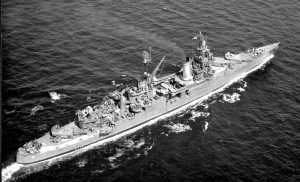
USS Indianapolis underway at sea 1943-44
The USS Indianapolis was a Treaty Cruiser built in conformance to the Washington Conference Treaty following World War I. She was designated CA-35 in the Navy’s inventory. Her keel was laid in late March 1930 under the covered ways of the New York Ship Corporation located on the Delaware River in Camden, New Jersey. Later, during the 1940s, this facility would become the world’s largest private shipbuilding facility employing more than 35,000 workers. The Indianapolis was launched November 7, 1931. Following her final fitting-out, she was commissioned by the Navy on November 15, 1932, at the Philadelphia Navy Yard.
The ship was considered a technological marvel, and she was the pride of the Navy. She was over 610 feet in length and 66 feet at the beam. She was designed for a flank speed of 32 knots. She was equipped with eight White-Forster boilers that turned four Parsons geared turbines. She had four screws and was rated at 107,000 horsepower.
She was armed with nine 8-inch guns in three turrets and four 5-inch guns. She also carried twenty-four 40mm medium range guns and thirty-two 20mm Oerlikon guns.
Following her shakedown deployment, in July 1933, the Indianapolis steamed to Bar Harbor, Maine to pick up President Franklin Roosevelt at his Campobello Island summer home and take him to Annapolis, Maryland. Thus began her long and distinguished role as a Ship of State and chosen transport for dignitaries and the president.
On December 5, 1941, the Indianapolis was ordered out of Pearl Harbor on an unusual and unexpected exercise to simulate bombardment of Johnson Island. The ship was given one hour’s notice and ordered out to sea with a third of her crew. Otherwise, the USS Indianapolis would have been moored to the Mine Dock at Pearl when the torpedoes began to fall.
This is where the curiosity begins. The Indianapolis was, after all, the president’s favorite ship and the flagship of Admiral Wilson Brown, head of Scouting Force. It was as if someone knew something was brewing.
With the outbreak of war, the Indianapolis saw her first combat some 350 miles south of Rabal, New Britain in February 1942. She was subsequently sent to the Aleutian Islands. In the spring of 1943, she became the Flagship for Admiral Raymond Spruance, Commander, Fifth Fleet. Admiral Spruance had won the naval battle at Midway.
On March 31, 1945, a Japanese Kamikaze flew into the USS Indianapolis during the battle for Okinawa. The plane didn’t do much damage but the bomb the plane released just before crashing penetrated armor on the port quarter and continued down through the crew’s mess, a berthing compartment, the fuel tanks and through the ship’s hull, exploding somewhere below the boat. The attack killed nine and injured twenty-six.
This attack and the resulting damage set in motion a series of events that would place the USS Indianapolis at the center of the worst single disaster at sea ever suffered by the U.S. Navy. Because of her damage, she was ordered to Mare Island, Vallejo, California, for extensive repairs in dry-dock. She arrived in late April 1945.
At 5:29:45 a.m. Mountain War Time on July 16, 1945, the sand of Alamogordo, New Mexico turned to glass. The conversion took less than a second and prompted Robert Oppenheimer to quote from the Hindu Bhagavad Gita, “I am become death, the destroyer of worlds.”
Those present and all forms of Gods in their Heavens had witnessed the first plutonium implosion, nineteen kilotons of Atomic Bomb. So, in the golden, purple, violet, gray, and blue morning sky lit by man’s first manufactured sun people suspended disbelief awestruck by their species’ tool-making achievement. But the military and political bureaucracy never sleeps and never tires, and was that very moment conjuring a way to get the new tool to where it could do some real good, or evil, depending upon which end of the device one found oneself.
Early that same morning, as fallout was raining on the molten glass wasteland of New Mexico, an outsized entourage of admirals, generals, technicians, and guards stood pier-side watching atomic bomb components being loaded aboard the USS Indianapolis. Wooden crates were stowed in the ship’s hangars and the uranium-235 for two bombs, sealed in a lead-lined metal container, was lashed to cleats then tack-welded to the deck in the Admiral’s Cabin. If this addition wasn’t sufficient cause for speculation by the uninformed crew, including Captain Charles McVay, strict orders were given that should the ship come under attack and find herself in extremis, the lead container was to be immediately jettisoned. And with that, the Indianapolis was off and running to Tinian in the Western Pacific.
The swift ship delivered her deadly tool in a record-setting run that averaged 29 knots. This included a six-hour stop at Pearl Harbor to refuel and replenish. It took less than ten days to cover the 5,300 nautical miles from California. A few days later, the Enola Gay B-29 bomber, flying at 31,060 feet, released the tool which promptly plummeted to its final destination 1,850 feet above Hiroshima, Japan. As the tool went about its business of converting matter to energy, 66,000 were killed instantly, and any sand in the vicinity was turned to glass. Another 74,000 died soon after that, and the Japanese began to rethink their war ambitions.
After delivering the bomb, the Indianapolis was sent south to Leyte Gulf on the East Coast of the Philippines. Some 1,500 nautical miles west of Guam, the fated ship was to join the USS Idaho for gunnery practice and refresher training. During its stop in Guam, a single coded message was sent to the Idaho about the rendezvous. The official record shows that the message was garbled on the receiving end and there was no request to repeat. So, the Idaho had no reason to expect the Indianapolis.
The Indianapolis steamed out of Guam on July 28, 1945, at a moderate 15 knots. When the watch changed at midnight July 29, the Indianapolis was making 17 knots bearing 262 degrees and secured from zigzagging. The fact that they weren’t zigzagging would play heavily into the future legal problems of Captain McVay.
Just after midnight, below the deceptively peaceful surface of the Western Pacific, Lieutenant Commander Mochitsura Hashimoto, positioned his 2,140-ton submarine, I-58, to launch a spread of torpedoes at the Indianapolis. Hashimoto selected to use conventional armaments although his boat had been modified to fire the 48-foot Kaiten manned torpedo and he had six weapons and their pilots onboard.
His first torpedo loaded with 1,200 pounds of Shimose powder struck and blew away the bow of the Indianapolis. The second hit starboard near a powder magazine and one of her fuel oil bunkers. The second explosion knocked out all electricity including radio transmitters. The radiomen onboard testified later that they had transmitted at least three S-O-S messages before power was lost.
In about twelve minutes, the ship rolled to port and went down bow first. Of the 1,197 souls aboard an estimated 880, many mortally wounded, burned and maimed, made it into the inky, oil-slicked waters alive. Their hapless bodies floated without provisions, no water, no food, very few life jackets, and even fewer rafts, scattered over thousands of yards of ocean. By the time they were rescued, they would be spread over twenty miles of water gathered in small clusters of floaters and rafters.
The next morning, as the sun peeked above the horizon, sharks began to pick-off men floating on the perimeter of clusters. Their screams were muffled only when water filled their lungs.
But surely, the survivors reasoned, their rescue would come quickly. The Indianapolis was, after all, the flagship of the Fifth Fleet. The USS Idaho was expecting them, and a search would surely commence shortly. So the floating, vulnerable, dehydrated, burned and shocked survivors hoped for the best but marshaled what provisions they had and planned for the worst.
Their flickering and faint hopefulness began to die along with more and more men on the second day in the water. By the third day, lack of food and fresh water and the remorseless terror from below pushed men beyond their limits. Dying of thirst, men began to drink the salty ocean water. Once they started drinking the salt water, their demise was inevitable, and the other men in their group would push them away to float alone. When the end came, the survivors retrieved their lifejacket and said the Lord’s Prayer as their body was set loose to drift below the unforgiving sea.
Hallucinations replaced reality and fights broke out. At the end of the third day, only four hundred men were still alive. Their lifejackets were waterlogged and losing their buoyancy, and the bodies of the dead floated alongside the living. All would have died, including dad’s buddy Jim O’Donnell the Indianapolis fireman, if it hadn’t been for a tool not quite so well designed as the atomic bomb.
On the fourth day, at about 1025 hours, Lieutenant Chuck Gwinn was piloting his Ventura PV-1 bomber out of Palau, about three hundred miles south of where the Indianapolis went down. He was on a routine antisubmarine patrol, his second of the day.
The tool that was giving his crew difficulty was a faulty antenna winch with a binding problem. So, Lieutenant Gwinn found himself leaning out of the plane, guiding the wire antenna when he saw what looked like a sizable oil slick. Believing the oil slick to be from a recently submerged submarine attempting to hide from his plane, he put the Ventura into a descent path and began a depth charge run. As he ordered the bomb bay doors open, he glanced once more at the ocean and to his astonishment saw hundreds of delirious men waving at him.
The young lieutenant immediately regained altitude and radioed Palau for help. His message was “Many men in the water,” and he gave his longitude and latitude. The Navy initially thought it was a prank and waited for confirmation. In the meanwhile, Lieutenant Gwinn descended and threw all the survival gear in his aircraft overboard for the desperate men below.
Three hours after his first broadcast, a Catalina PBY flying boat was dispatched with a twenty-eight-year-old pilot from Frankfort, Indiana at the controls. En route to the survivors, Lieutenant Adrian Marks overflew the USS Cecil Doyle and radioed its captain. He told the captain of his mission and of his own initiative Graham Claytor diverted the craft from its ordered course to aid in the rescue.
When Marks arrived, he dropped the PBY to about 100 feet and began offloading rafts and supplies. While throwing the items overboard, the crew reported that they saw men being attacked by sharks. The PBY’s crew voted to abandon standing orders and land on the roiling open sea in their relatively frail amphibious airboat. Such a landing was entirely against regulations and standing orders. But the brave men made a selfless humanitarian decision and put at risk their own lives without knowing the nationality of the men in the water. They could have been Japanese for all they knew.
They approached between swells in a power stall, tail-low, nose-high attitude. The PBY took a beating, popping rivets out of its hull and jarring the brave crew, but landed in one piece. Marks taxied to the nearest group of men and began taking survivors onboard. The PBY’s crew helped the ones with enough strength to swim to the plane and lugged the weary men onto the fabric wings of the aircraft. The PBY would never fly again, but it saved fifty-six men that night.
The USS Cecil Doyle, Talbot, and Dufilho converged on the survivors and eventually pulled 317 men from the water, 317 out of 1,197. That’s about a one-in-four chance of survival, and Jim O’Donnell beat the odds. Jim would put his good fortune to good use and return from the war to marry Mary and raise a wonderful family. He was eventually named “Man of the Year” by the Indianapolis Star in 1996 for his efforts on behalf of the survivors and his role in constructing an officially recognized memorial in Indianapolis to the USS Indianapolis.
Captain McVay was court-martialed for “hazarding his vessel by failing to zigzag.” Although the conviction stayed on his record until 2001, well after his death, Admiral Chester Nimitz remitted his punishment in 1946.
Captain McVay was able to continue his Navy career, but his life did not unfold well, and in 1968 he committed suicide. He was found with his .38-caliber service revolver in one hand and a toy sailor attached to a key ring in the other. After his trip to the United States to testify at McVay’s court-martial, Hashimoto spent the rest of his ninety-one years in Kyoto, Japan as a Shinto Priest pursuing no longer enemy ships but the way of the kami.
The sinking of the Indianapolis was big news on Tinian. At 0130 hours on August 6, 1945, the men of the Enola Gay scrawled “A present for the souls of the Indianapolis crew,” on the tool they would deploy at 0815 hours to 1,850 feet above Hiroshima.
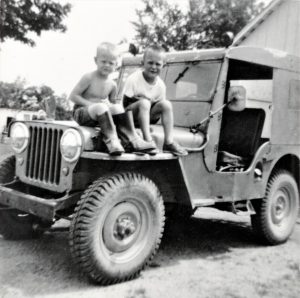
Tom & Steve Hantzis, Circa 1955
As we sat around the Formica-top, chrome trimmed kitchen table eating fried chicken and rabbits, the boys kneed each other and giggled when my brother ate his mashed potatoes with a celery stick. The men talked about…whatever. And that’s the thing. I don’t recall Jim and Jim talking about the war. And believe me, war stories would have been soaked up by the boys like gravy on white bread. I think the Jims talked about work and old friends and made inside jokes with the Marys. I’m sure they talked about cars, football, and basketball as well.
So, Jim O’Donnell and Jim Hantzis would talk about boring subjects, the boys would haul the rabbits and occasionally get a thrill ride in dad’s 1949 four-wheel-drive jeep, and the Marys would talk about life on the farm, life in the city, old friends and the intricacies of raising boys. Our get-togethers were perfectly regular, predictable and wholesome occasions and I wish like hell I could listen in to one of them today. But as mom use to say, “If wishes were horses, we all could ride.”
If I could listen in today, it would still be a long shot that I might hear Jim O’Donnell talk about the USS Indianapolis. He told a local publication a few years back, “Everybody just wanted to put the experience in the past. It was always there, but you never talked about it.” I would probably have heard a lot of talk about how good the potatoes were or how some rabbit out-foxed one of the Jims. It’s likely the tough guys would never have said how tough they were. – © 2008 Steven James Hantzis
I have, at times, introduced myself as a recovering motorhead. I’m still working on it. About ten years ago I gifted my British racing green Triumph Spitfire to my daughter and sold our lumbering Jaguar V-12 convertible. Then, I bought a real car, a 2003 Mercedes SL500. A lovely car, the best I’ve ever owned. For those uninitiated in the dense nomenclature of Mercedes Benz, SL stands for Sportlich-Leicht. It was a grand-touring roadster.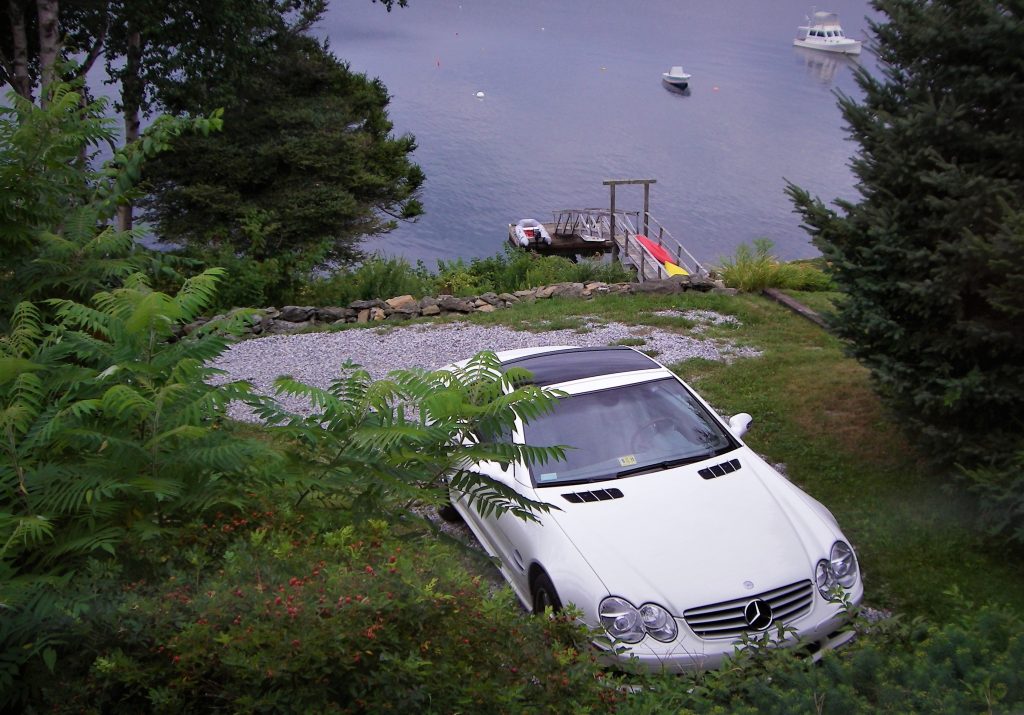
The SL was unalloyed white, Germany’s international racing color. It featured a sumptuous gray-ash leather interior, burl wood accents, and a burl steering wheel. It was rolling art by any other name. At the touch of a button, its glass hardtop tucked into the trunk like a scene from a Transformers movie. With the top in the boot, the car was nearly windless thanks to Teutonic aerodynamic wizardry. With its sophisticated ultra-high pressure magnetic fluid suspension and its massive Michelins mated to a five-liter V-8, it handled like it was on rails.
I bought the SL used with thirty thousand miles. I pampered it for eight years and drove it from Key West to Calais, Maine. It never faltered and never failed to put a smile on my face and never failed to go fast when I wanted to. Last summer I drove it to Maine and decided it was more useful in the Pine Tree State than in Alexandria. I never liked driving in the DC area where people are rude, open car doors with abandon, smash into parked vehicles, and generally have little or no regard for nice things. And, if DC drivers don’t get you, the potholes will. In Maine, it would lead a lazy life of top-down, blue highway cruising where I would soak in the natural beauty, and coastal vibe and the only depreciating challenge would be sand in the floor mats.
And, that’s what happened – until I put it away for the winter.
In mid-November, I washed the SL, treated the leather interior, connected a battery tender, and left Maine with the knowledge that our modern two-car garage would provide shelter and a bit of warmth during the coming cold and dark. But, when we returned to Maine the week following Christmas, things got weird.
Mus musculus Linnaeus, 1758.
It was cold in Maine the week we returned. For eleven days high temperatures never rose into double-digits, and the lows were below zero. So, yes, I understand why any living creature would appreciate the relative warmth and shelter of our garage. I can appreciate this, but I never agreed to it. Not that anyone asked.
My first clue that there was a problem came when I started the SL to make sure it was okay. It wasn’t. That’s when I got the stomach-punching “Visit Workshop” message displayed in the instrument cluster. Then, the SL would not turn off. The engine kept running with the key out of the ignition. When I popped the hood to block the air intakes to kill the engine, I saw a dead mouse in the engine bay.
Along with the “Visit Workshop” message the SL told me to “Raise Roll-Over Bar.” This message, I had never seen before nor could I find anything related to it on the Mercedes owner’s group sites.
So, in early January, I tucked away this problem for a warmer time and set some old-fashioned spring traps in the garage. I was in Maine roughly four weeks between January and April and caught twenty-four invaders. In April, I mustered the courage to start troubleshooting the SL, and my first line of investigation was the fuse box-relay area behind the passenger’s seat. I popped the plastic cover under the leather interior panel, and there it was an abandoned utopian mouse commune. Abandoned because I had presumably trapped all the whisker-twitching cultists. They had used the sound insulation that Mercedes had thoughtfully padded the noisy bits with to build a bunker precisely over the fuse box, critical relays, sensors, and circuits. Then, they peed on everything and chewed the hair-width wiring that communicates the driver’s wishes and demands and conducts the neural network of SL’s deep state automotive consciousness.
I sucked everything as clean as I could with my Shop-Vac, got a magnifying glass and inspected the havoc. And, yes, it was chewed on, and peed on, and generally as smelly as you might imagine but please try not to. This filthy blight in mind-numbing proximity to pristine gray-ash leather and burl drove me to the brink. I was in motorhead shock. My cherished object of attachment the bonds to which I had forged with meticulous stewardship and my pride in its very existence within the orbit of My Things had transmuted to anxiety, maybe even panic. The onset of a separation complex hit me like a homesick freshman. It was a week before I regained nominal emotional equilibrium and the problem solver kicked in. I called Dan’s Auto.
Dan’s a square shooter and Joe, the tech who tried to mend the SL, is a stand-up guy and a patient caregiver. But, they had no luck. That’s when I called Prime Motors in Scarborough, Maine, the nearest Mercedes dealer. There would be access to the latest proprietary Mercedes diagnostic equipment and trained techs familiar with the SL’s cognitive elements, relay modules, and nervous system.
I took it to Prime, and the next day the service writer called and suggested I contact my insurance provider. I did and, yep, it was a total loss. The investigating tech estimated that over 100 of the tiny little wires would have to be repaired, and modules galore would need replacing. The service writer said the retractable hardtop module alone would cost $3,100. Thus came to an end an eight-year relationship with the best car I had ever owned. I kid not when I say I would have kept it for another twenty years or willed it to my daughter.
So, what’s the revenge? How does one go about killing every mouse and their relatives in the State of Maine?
My first line of inquiry was cats. Your every day, unrepentant American shorthair tabby is a prodigious mouse killing machine batting one-in-three, that’s a .333 OMP (On Mouse Percentage). They are nature’s Hall of Famers all. A quick online search found a feral cat support group in Portland that sells fixed and neutered “barn cats,” preferably in packs of three or more. But, I don’t have a barn. So, I tried to enlist our next-door neighbors because they have an unattached garage that might qualify as a barn, and they too, had suffered terribly this past winter when their lovely home was attacked by a vile coalition of mice, woodpeckers, and chipmunks. And, by the way, everyone says that this past winter saw an epic reign of mouse predation. Some blame it on the bumper seed crop from last year’s good growing season. Anyway, after thoughtful discussion and applied game-theory analysis over bottomless cocktails, it was decided that introducing feral cats onto Barters Island might be socially disruptive. It seems that not everybody likes feral cats. And, since our neighborhood cat, Tilly, is too well fed to bother with scruffy mice, cats as a revenge strategy were out. No, my revenge will come in a more personal and engineered form. Vengeance made of my own hands.
Before enlisting Google, I heard from three Mainers about, what I’ve deemed, the Maine Mouse Bucket. Now, before I go further, this device can be used to live-trap the vermin for kindly redistribution to someone else’s yard but I’m Greek, and it’s payback time.
If you Google “Maine Mouse Bucket” as I did, you’ll see a cheap and reportedly efficient method of trapping and dispatching mice in an abyss of deadly hubris. As I dove deeper into my research, I found that the whole world has arrived at similar inexpensive anti-mouse-rat innovations. All involve a bucket and a seemingly obvious but secretly perilous route to bait nirvana. So, assuming that Russian bots have no interest in manipulating this corner of the internet, I’m convinced that the Maine Mouse Bucket will do the trick and free my soul of its honor-bound debt. I’m on my way to Grover’s Hardware now, and I’m building at least three. Overkill? Impossible. – SJH
In the Weeds in Palmer

Scarlet
What makes a railroad town? There was a time when seven railroads chugged through Palmer, Massachusetts. Now there are four railroads, and the one passenger number, Amtrak’s Lake Shore Limited, doesn’t stop. But, railroading is not dead in Palmer, quite the opposite. Palmer is a town of working railroaders, motivated historians, and rail buffs, with civic aspirations for again becoming a stop on Amtrak’s timetable.
Palmer provided a generational double-whammy. The demographic profile was predictable at my well-attended Amherst Railway Society presentation. Railroad enthusiasts are often male and often of a certain age. I treasure them all. I also met a young woman, a recent Western New England University graduate, who is all about returning rail service to Palmer and is knee-deep in the politics of getting it done. She is a spark in the ether, if you will, or perhaps a glowing ember in the sooty plume of a relic locomotive.
Scarlet Lamothe will tell you that rail transport is the future; it’s efficient, environmentally sound, and a safe way to travel. She’ll contend that better rail service means fewer Massachusetts drivers, and all Americans can get behind that. She’ll tell you that her great commonwealth was a leader in founding this country and it now needs to lead in infrastructure innovation. Yes, Scarlet is irrefutably correct on every point. And lastly, she’ll note Palmer’s ideal location, already primed architecturally accredited station, secure parking, and excellent restaurant, the Steaming Tender. And, again, she’s right on every point. Scarlet is articulate, bright, and engaging. So, who could resist?

Massachusetts State Senators Anne Gobi, Eric Lesser, & State Rep. Todd Smola – Palmer Rail Supporters
Well, you guessed it, the political class and the bureaucratic apparatus it controls but often hides behind. There lies resistance. But, Scarlet’s going to win. And, Palmer’s going to win. Put money on it. It’s a matter of will finding a way.
My guilty pleasure in Palmer was speaking to eighty or more rail enthusiasts on a dreary Wednesday night and not only telling the story of the 721st Railway Operating Battalion but getting into the weedy details of railroading without losing the audience. Most people don’t care about the advantages of a Westinghouse air brake system over a vacuum brake system or the operational hazards of link-and-pin coupling versus the efficient and much less dangerous drawbar-knuckle system. I do, and I like talking about these things. Rambling on about railroad minutiae is typically a selfish pleasure, but not in Palmer. The Palmerians were ready for details.
The well-organized Amherst Railway Society fielded an outstanding audience on a slushy post-Nor’easter weekday evening. Kudos to John Sacerdote, President and Show Director. So, here’s something to put on your calendar. Next January 25-26, 2019, the Amherst Railway Society Railroad Hobby Show, the largest show of its kind on the East Coast, will kick off in West Springfield, Massachusetts. I’ll be there, and I look forward to riding Amtrak to Palmer, having a drink at the Steaming Tender, then traveling on to Springfield. There, I plan to get into the weeds with anyone looking for scintillating railroading details. All aboard! – SJH

Amherst Railway Society Railroad Hobby Show
First Impressions

We bought our house on Barters Island in Boothbay, Maine in August 2016. We closed on the 12th and the 17th, the third Wednesday of the month, as regular as the tide, the Barters Island Community Association held its monthly Potluck. We were newbies, but we decided to go and introduce ourselves.
Barters Island is a small island in the Sheepscot River connected to the Boothbay Region by the Trevett Bridge, one of the last human-powered swing bridges on the planet. When a boat hails for passage on VHF radio channel 9 or 13, a bridge tender comes out of her shack, lowers the traffic barriers, and then proceeds to the center of the bridge with a six-foot-long lever. She attaches the bar to a spindle in the center of the bridge and rotates the gearing twenty-four times. Once she gets everything in motion, if the wind is blowing right, she can push the lever and stand in one position without needing to walk behind it. The bridge dutifully turns ninety degrees, the boat passes, and then the tender engages the 96:1 gearing in the opposite rotation and the bridge closes. The traffic barriers are opened, often with the help of local motorists, and all returns to normal so the 318 residents of Barters Island are free to come and go as they please.
Barters Island is an old place. According to the Boothbay Region Historical Society, Mr. Samuel Barter, a housewright born in 1711, left Arundel, Massachusetts and settled on Barters Island about 1737. Back then, Maine was a colony of Massachusetts who was a colony of Great Britain. By the way, the correct local pronunciation of Barters is Batters.
Kathy and I arrived at the Barters Island Community Center, filled out our name tags, and began introducing ourselves to the friendly and welcoming forty-or-so-residents in attendance. A Barters Island Potluck involves drinks and appetizers, the main course buffet, and a dessert table. Nothing fancy and nothing overly-programmed. No one puts on airs.
Between the main course and the dessert, the Community Association president, Evelyn, made her report. The Association had helped a couple of Barters Island families who had fallen on hard  times. Evelyn reviewed the fall calendar and entertained other announcements. Then, Evelyn kicked-off a raffle. The item to be won was a hod of dug-that-morning quahog clams and a bottle of oak-aged Chardonnay. A hod, by the way, is a half bushel basket, a clammer’s tool, constructed of wooden lathes and sometimes called a roller.
times. Evelyn reviewed the fall calendar and entertained other announcements. Then, Evelyn kicked-off a raffle. The item to be won was a hod of dug-that-morning quahog clams and a bottle of oak-aged Chardonnay. A hod, by the way, is a half bushel basket, a clammer’s tool, constructed of wooden lathes and sometimes called a roller.
The locals had sussed out that my attractive, outgoing, and personable wife was a Certified Public Accountant. So, after the fundraisers worked the hall and after I played along buying $20 worth of tickets, it was time for the awaited drawing. Evelyn’s hand was almost in the Tupperware ticket trove when she announced, “Wait, we’ve got a CPA here. Let’s let her draw.” So, Evelyn held the plastic bowl above Kathy’s head, and Kathy reached up and in, and the first ticket out was, of course, mine. That’s the way to make a first impression. I might have re-donated the quahogs, but they looked delicious that warm August evening piled against the chilled, sweating bottle of wine. So we kept them and steamed them for lunch the next day. I still have some in the freezer waiting for chowder. I’ll invite our neighbors when I get around to making it.
By the way, if you want to see the human-powered Trevett Bridge in action, you better do it this summer. According to the Maine Department of Transportation (MDOT), the 86-year-old pony truss structure is clanking and not in a good way. MDOT says it’s time to go, time for an electric motor and a computer interface and so long to Terry, the smiling tender. I wonder if 8.1 million dollars’ worth of technological advancement will make as good a first impression as Terry circling with her lever. – SJH



